MAR. 9 2024 ▪ ד"פשת ׳א רדא
SHABBAT





Neither More nor Less Rabbi Dr. Tzvi Hersh Weinreb Pg 18
The Arrivals Hall at Ben Gurion Airport
Shoshana Judelman Pg 72
תרפכה־תא וידב־תאו ןראה־תא ב״י:ה״ל תומש
ADVERTISING & SPONSORSHIPS 02-560-9125 TorahTidbits.com OU ISRAEL 02-560-9100 YERUSHALAYIM SHABBAT
CANDLES 5:06 PM • HAVDALA 6:20 PM • RABBEINU TAM 7:00 PM ה"ב ISSUE 1556
PARSHAT VAYAKHEL ZMANIM
ט״כ
להקיו תשרפ PARSHAT VAYAKHEL
ךסמה תכרפ תאו
MEVARCHIM & SHEKALIM
04
12
58 First Tzedakah Box
Rebbetzin Dr. Adina Shmidman
62 Completing the Half-Shekel Rabbi Aaron Goldscheider
66
Reattaching Ripped Tzitzit
Rabbi Daniel Mann
68 Transporting the Ark Rabbi Gideon Weitzman
72 The Arrivals Hall at Ben Gurion Airport Shoshana Judelman
74 How Do We Emerge From Darkness Into Light?
76
78


2 TORAH TIDBITS 1556 / VAYAKHEL
Table of Contents
Sivan Rahav Meir
Netanel Epstein
The Y-Files Weekly Comic
Yachad Aviyah Atkin // Yitz Shmidman
Dear Torah Tidbits Family Rabbi Avi Berman
True Unity
Moshe Hauer
08
Rabbi
Aliya-by-Aliya Sedra Summary
Reuven Tradburks
More nor Less Rabbi Dr. Tzvi Hersh Weinreb
A Complicit World Rabbi Shmuel Goldin
God’s Shadow Rabbi Lord Jonathan Sacks zt"l 32 Probing the Prophets Rabbi Nachman Winkler 34 The Individual and Society Rabbi Shalom Rosner 36 Desirable Donations Rebbetzin Shira Smiles 40 Schedule OU Israel 50 Gather! Rabbi Judah Mischel 52 Simchat Shmuel Rabbi Sam Shor 54 The Second Time Around Rabbi Moshe Taragin Earliest Kiddush Levana, 3 Days After Molad: 4 Adar Bet/ Wed. night March. 13 7 Days After Molad: 8 Adar Bet/ Sun. night March 17 Last Opportunity to Say Kiddush Levana until: 15 Adar Bet/ Sun. night March 24 רקבב רשע ירחא םיקלח הששו ,תוקד הרשע שלש ,ןושאר םויב היהי דלומה הבוטל לארשי לכ לעו ונילע אבה ינש םויבו ןושאר םויב רחמ היהי ינשה רדא שדח שאר Rosh Chodesh Adar Bet is on Sunday, March 10, and Monday, March 11 IMPORTANT REMINDERS This Shabbat we read Parshat Shekalim as a reminder that the due date for the half shekel was approaching in the time of the Beit Hamikdash
Rabbi
18 Neither
22
26
THIS WEEK'S COVER PHOTO
by Zeev Schwartz
Temple Institute Special thanks
Tidbits.
Photographed
-
to Nina Broder for sharing this photo with Torah
CANDLE
All Times According to MyZmanim (20 mins before Sunset in most Cities; 40 mins in Yerushalyim and Petach Tikva; 30 mins in Tzfat and Haifa)
Daf Yomi: Kidushin 69
OU Advocacy OU Israel MITCHEL R. AEDER, PRESIDENT OF THE ORTHODOX UNION Yehuda Neuberger, Chairman of the Board, Orthodox Union | Dr. Josh Penn, OU Kashrus Commission RABBI MOSHE HAUER, EXECUTIVE VICE PRESIDENT | RABBI JOSHUA M. JOSEPH, ED.D.
EXECUTIVE VICE PRESIDENT & CHIEF OPERATING OFFICER Rabbi Dr. Tzvi Hersh Weinreb, Exec. V.P. Emeritus
OU KOSHER: Rabbi Menachem Genack, CEO/Rabbinic Administrator OU Kosher | Rabbi Moshe Elefant, COO/Executive Rabbinic Coordinator ISRAEL: Rabbi Yissachar Dov Krakowski, Rabbinic Administrator | Rabbi Ezra Friedman, The Gustave and Carol Jacobs Center for Kashrut Education/ Deputy Rabbinic Administrator
Headquarters: 40 Rector St. 4th floor, New York, NY 10006 212-563-4000 website: www.ou.org
Editor Emeritus: Phil Chernofsky
Editor: Rabbi Aaron Goldscheider | aarong@ouisrael.org
Advertising: Ita Rochel | 02-5609125 or ttads@ouisrael.org
Website: www.torahtidbits.com
Not getting enough TTs? Too many? None at all?
Contact our DISTRIBUTION 050-577-2111 • ttdist@ouisrael.org
JERUSALEM
Ranges 11 days Wed - Shabbat
Oct x - x / x - x Cheshvan
Earliest Tallit and Tefillin x:xx - x:xx
Sunrise x:xx - x:xx
Sof Zman Kriat Shema x:xx - x:xx
Magen Avraham x:xx - x:xx
Sof Zman Tefila x:xx-x:xx (According to the Gra and Baal HaTanya)
(According to the Gra and Baal HaTanya) Chatzot
-
Chatzot (Halachic Noon) x:xx - x:xx
Mincha Gedola (Earliest Mincha)
- 12:17
Mincha Gedola (Earliest Mincha) x:xx - x:xx
Plag Mincha
- 4:32
Plag Mincha x:xx - x:xx
Sunset (Including Elevation) x:xx - x:xx
Sunset (Including Elevation) 5:45 - 5:52
Seymour J. Abrams • Orthodox Union Jerusalem World Center • Avrom Silver Jerusalem College for Adults • Wolinetz Family Shul • Makom BaLev • Birthright • Yachad • NCSY in Israel • JLIC in Israel • Camp Dror • Pearl & Harold M. Jacobs ZULA Outreach Center • The Jack Gindi Oraita Program • OU Israel Kashrut
STUART HERSHKOWITZ, PRESIDENT OU ISRAEL
Zvi Sand / Yitzchak Fund: Former Presidents, OU Israel | Rabbi Emanuel Quint z”l, Senior Vice President | Prof. Meni Koslowsky, Vice President
VAAD MEMBERS:
Michael Elman | Yonatan Frankel | Yitzchak Fund | Daniella Hellerstein | Stuart Hershkowitz | Jeremy Lustman | Meir Raskas | Atara Reichel | Zvi Sand | Norman Schmutter | Mark Schneider | Esther Williams
RABBI AVI BERMAN, EXECUTIVE DIRECTOR, OU ISRAEL
David Katz, CFO, OU Israel | Natan Kandler, COO, OU Israel | Chaim Pelzner, Director of Programs, OU Israel | Rabbi Sam Shor, Director of Programs, OU Israel Center | Rabbi Sholom Gold zt"l, Dean, Avrom Silver Jerusalem College for Adults
22 Keren HaYesod <> POB 1441 <> Jerusalem 9101032
phone: (02) 560 9100 | fax: (02) 561-7432
email: office@ouisrael.org
website: www.ouisrael.org
Founders and initial benefactors of the OU Israel Center: George and Ilse Falk a"h
Torah Tidbits and many of the projects of OU Israel are assisted by grants from THE JERUSALEM MUNICIPALITY

OU Israel, Torah Tidbits does not endorse the political or halachic positions of its editor, columnists or advertisers, nor guarantee the quality of advertised services or products. Nor do we endorse the kashrut of hotels, restaurants, caterers or food products that are advertised in TT (except, of course, those under OU-Israel hashgacha). Any "promises" made in ads are the sole responsibility of the advertisers and not that of OU Israel, the OU Israel Center , Torah Tidbits.
OU ISRAEL CENTER 3
TIMES
AND HAVDALA
LIGHTING OTHER Z'MANIM
OU Kashrut NCSY Jewish Action JLIC NJCD / Yachad / Our Way OU West Coast OU Press Synagogue/Community Services
March 6 - 16 / 26 Adar Aleph - 6 Adar Bet 5:09 - 4:57 6:00 - 5:47
Zman Kriat Shema 8:55 - 8:47 Magen Avraham 8:19 - 8:11
Zman Tefila 9:53
9:47
Sof
Sof
-
Noon) 11:50
(Halachic
11:47
12:20
4:27
Daf Yomi: Bava Metzia 10 PEKUDEI VAYAKHEL HAVDALA CANDLES HAVDALA CANDLES 6:25 5:11 6:20 5:06 Yerushalayim / Maale Adumim 6:27 5:29 6:22 5:25 Aza Area (Netivot, Sderot et al) 6:26 5:30 6:21 5:25 Beit Shemesh / RBS 6:25 5:27 6:20 5:22 Alon Shvut 6:26 5:28 6:21 5:23 Raanana / Tel Mond / Herzliya / K. Saba 6:26 5:28 6:21 5:23 Modiin / Chashmonaim 6:26 5:28 6:21 5:23 Netanya 6:26 5:29 6:21 5:24 Be’er Sheva 6:26 5:28 6:21 5:23 Rehovot 6:26 5:11 6:21 5:06 Petach Tikva 6:25 5:27 6:20 5:22 Ginot Shomron 6:26 5:18 6:21 5:12 Haifa / Zichron 6:24 5:27 6:19 5:21 Gush Shiloh 6:27 5:29 6:22 5:24 Tel Aviv / Givat Shmuel 6:25 5:31 6:20 5:26 Givat Zeev 6:25 5:27 6:20 5:22 Chevron / Kiryat Arba 6:27 5:30 6:22 5:25 Ashkelon 6:26 5:28 6:21 5:23 Yad Binyamin 6:24 5:20 6:19 5:14 Tzfat / Bikat HaYarden 6:23 5:25 6:18 5:20 Golan 6:26 5:26 6:20 5:21 Nahariya/Maalot 6:25 5:26 6:20 5:21 Afula Rabbeinu Tam (Jerusalem) - 7:00 PM • Next Week - 7:05 PM

DEAR TORAH TIDBITS FAMILY
DEAR TORAH TIDBITS FAMILY
RABBI AVI BERMAN Executive Director, OU Israel aberman@ouisrael.org
I am the oldest in my family. While I have five amazing siblings, being the oldest can have its challenges. I found this out soon after my family made aliyah in 1985, when I was nine years old. As the oldest child, no one in my family could have prepared me for what Rosh Chodesh Adar is like in Israeli schools, especially in dormitory schools. There are many beautiful Israeli customs I had to learn to navigate as a young oleh chadash, but this one was really special for me.
Rosh Chodesh Adar was a day that everybody in school waited for, basically from the first day of the school year. It didn’t matter if you were just starting elementary school, junior high, or high school, or if you were in your last year of these schools, you felt it. I can clearly remember coming into yeshiva in Ohr Etzion in 9th grade, and not quite understanding the hype in yeshiva the day before Rosh Chodesh Adar. There was a buzz of excitement in the air. There was a tremendous amount of whispering and a lot of passing notes in class.
Dedicated in loving memory of Laura Spiegler a”h
RABBI AVI BERMAN Executive Director, OU Israel
I remember that the senior class made sure the freshmen were all in the dorms after 10:30 pm and the school was cleared out for them to be able to pull the pranks they had planned for that year. Even though it was the 12th graders pulling the annual pranks, we were so willing to let them do their stunts because we knew that in three years’ time, it would be us running the pranks and coming up with crazy and creative ways to bring in Adar.
It was here that I saw just how serious Adar was taken in yeshiva. The goal of these pranks was to take our teachers and the rest of the school by surprise, of course while not harming anyone in the process. I can remember them so clearly from my time. One year we made a pyramid of the tables and chairs towering over the yeshiva. Another year, we built a literal brick wall at the entrance to the building, barring anyone from entry. One time, we took the teachers’ and rabbis’ bicycles and hung them up by ropes from one rooftop to the other of the buildings of the yeshiva.
I don’t know if they still are like this, but I remember that none of us could sleep the night before, we were so excited. The amount of effort that went into the planning and execution of these pranks was unbelievable. To be honest, looking back, it was all kind of pointless, but it was a lot of fun nevertheless.
Adar puts us in a funny mindset. We all know, “Mishenichnas Adar, marbim
4 TORAH TIDBITS 1556 / VAYAKHEL
ה”ע והירמש תב הבוהא ו”עשת ’ב רדא ’ב and Ethel Spiegler a”h ה”ע יולה לאומש תב ליטע ה”סשת ’ב רדא ’ג on their yahrzeits

besimcha” - “When Adar enters, we increase our joy.” We get really happy, overflowing with rejoicing and merriment. But I think we can all feel that this year is different. It seems harder to get into this mode, with the current situation. The thought of getting my kids ready with their costumes and thinking about preparing mishloach manot, and even just the joy of Purim itself, it causes a very strange feeling for me, a very different vibe this year.
About three weeks ago, I found myself talking to a number of women - some from Israel, and some from America - and they were discussing whether they felt Purim parties should be canceled this year or not. At a certain point, they turned to me and asked, “Rabbi Berman, what’s your opinion?” I told them that I think that children should not lose out on Purim because we’re going through a challenging year. As it is, they’re already aware of what’s going on, hearing all sorts of sad and unsettling news from their parents, rabbis, teachers, classmates and the media. Another soldier falling. Another family that lost a child. Another mother that has to bury her son.
Purim, alongside all of our holidays, is linked to the eternal history of the Jewish People. If we let it be decided according to the needs of right now, we send a terrible message to our children that we define things according to the present, and do not see this Purim as another year where the Jewish People overcome challenges, strive higher, and get stronger. Stopping the happiness of Purim says that we are hopeless, and I just don’t think that’s true.
So, it’s important to me that Purim parties, especially children’s parties, continue even this year. True, we do need to be extra sensitive this year. This is not an ordinary year, and we must have those who cannot celebrate in mind with us. But we also need to show our youth, and ourselves, Am Yisrael Lo Mefached, the Jewish People are not scared. Even though there are challenges, we are here for the long run. Our children must learn that from us.
There is something I suggested to those women that should mark a difference between this year and other years. I believe that this year, we should not allow our children to use firecrackers or pop guns on Purim. We have so many people who are literally just coming out of the fighting in Gaza. So many people are still in trauma. This is clearly not a year for toy guns to be part of our Purim celebrations.
That is a practical suggestion. Nevertheless, the joy must continue. When Adar comes in, that is an indication that we have
OU ISRAEL CENTER 5
two weeks to plan. Two weeks to invite, to create mishloach manot, to donate money to be distributed to the poor, to make parties and to rejoice. I really hope that yeshivot and schools will continue the atmosphere of excitement and cheer that are hallmarks of Israeli Adar celebrations. I hope they will continue their annual rabbi-student basketball games. I hope they will continue their Shuk-Purim. I hope all the fun activities schools do to be marbim besimcha, increase joy, during the month of Adar will continue this year. The children and teenagers of today should see it. They need it. They need to know we are still happy. That we know that those who try to destroy us, like Haman so many years ago, will themselves be destroyed. Like it happened then, so will we be successful now with the help of Hakadosh Baruch Hu.
We need to show our children that our role in this world is to bring light, and to clear away the darkness. This more significance than ever. So we cele brate this Purim, with all of its must think of those who need our help. Of those who cannot yet return home. There are teenagers that have not been home since Simchat Torah little kids, who have not slept in their own beds since October 7th. With your gener ous help, OU Israel will be doing activities all over the country in preparation for Purim. We’ll be sending to soldiers on army bases. We’ll be sup porting teenagers who are evacuated from their homes and making sure they have a happy Purim as well.
Be’ezrat Hashem, I’m looking forward to a sensitive, yet most of all joyous Purim this
year. Wishing you all a happy Adar and Chodesh Tov. We should see lots of simcha in Klal Yisrael.
Wishing you all an uplifting and inspiring Shabbat, Rabbi Avi Berman Executive Director, OU Israel aberman@ouisrael.org










6 TORAH TIDBITS 1556 / VAYAKHEL
Sofas Cleaning Carpet Cleaning Mattress And more cleaning services Curtains Polish 050-445-5975 info.talclean@gmail.com F O R M O R E I N F O R M A T I O N , V I S I T W W W T A L C L E A N C O I L Contact us:









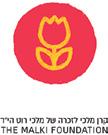




OU ISRAEL CENTER 7 MASSAGE THERAPIST & FITNESS TRAINER 052.673.3704 I www.andyhealth.com | jerusalemmyhome@hotmail.com TUVIA ANDY HAAS BALANCE and FALL-PREVENTION SPECIALIST for OLDER ADULTS Maintain Healthy Bones and Muscles Decrease Stiffness and Joint Pain Increase Strength! Stay Independent! True wholesaler from the diamond boursa with over 25 years experience member diamond dealers club Engagement Rings ∙ Stud Earrings Pendants ∙ Tennis Bracelets 050-573-9061 jeffmor36@gmail.com www.JeffMorDiamondJewelry.com kerenmalki.org 02-567-0602 Keren Malki empowers families of children with special needs in Israel to choose home care. Donations are tax-approved in Israel, US and UK. Honoring the memory of Malka Chana Roth ד”יה 1985-2001, killed in the Sbarro bombing.

FROM THE DESK OF RABBI MOSHE
OU EXECUTIVE VICE PRESIDENT
True Unity
We are all rightly preoccupied with the profoundly unsettling events of the past months. War, loss, and dislocation have traumatic effects that are currently being experienced by so many. It is not only their problem; it is ours. Klal Yisrael has taken this to heart and responded with an inspired generosity of spirit, compassion, and resources that has crossed geographic, social, and ideological boundaries. This unity of spirit stands in sharp contrast to the sharp ideological divisions that produced so much internal strife and hatred preceding this war and that are sadly beginning to reappear.
Ideological divisions can tear us apart when we lose sight of the essential unity between us that makes it so natural for Jews everywhere to drop everything to do more for each other. They tear us apart when we forget that the future of the Jewish people is a joint project involving every part of our people. Our ideological divisions, however sharp, must never overwhelm the love and commitment we viscerally feel for each other and our commitment to a shared destiny.
Vayakhel Moshe – Moshe brought together the community. Ramban notes that this was the first step of the actual building of the Mishkan as this was to be
a collective project, brought to fruition through the participation of the entire community. This is also the theme of Parshat Shekalim, where everyone was mandated to give a half shekel for the building project, making it a truly shared enterprise. The Talmud (Megillah 13b) teaches that this national campaign to fund the Temple service that was initiated each year on Rosh Chodesh Adar served as the antidote to Haman’s scheme in the story of Purim (see Tosfos Megillah 16a). This commitment to the joint national enterprise spiritually set the stage for our eventual victory in the Purim battle that the Talmud (Megillah 2a) refers to as zman kehilla lakol, a time when everyone needed to come together to stand up for their survival, l’hikahel v’la’amod al nafsham.
We therefore celebrate Purim as a day of unity and ahavat Yisrael. In the Megillah, the call for unity was not symbolic or shallow; it was raw and real. Esther was safe in the palace, secure in her anonymity as she was not known as a Jew. But as Mordechai told her, a choice to escape the fate of the Jewish people would have led her to oblivion rather than survival. Instead, she realized she was an inseparable part of her people and chose to step forward and risk her life for the sake of the Jews, gaining for herself eternity. To Esther, her connection to her people was not a slogan; it was her reality. We emulate this in our own way
8 TORAH TIDBITS 1556 / VAYAKHEL
each Purim – meaningfully though not nearly as dramatically - when we deploy our resources to benefit others in fulfillment of the mandates of mishloach manos u’matanos l’evyonim, coming together to provide each other with care and support.
It remains essential that we all keep these values and feelings at the forefront. The future of Klal Yisrael is our shared enterprise. We need each other, we love each other, and we will do anything for each other. Those feelings must dominate the future if we are to avoid repeating the tragedy of the recent past.
 donated by Marion & Michael Silman Ita Rochel 02-560-9125
donated by Marion & Michael Silman Ita Rochel 02-560-9125






OU ISRAEL CENTER 9
2024/03/04 13:10

and our next step will be to plant a fruit tree. I never thought of myself as being the agricultural type, but the feeling of settling and planting a portion of Eretz Yisrael, has been truly euphoric. Iy”H, when we plant our tree, and eat the fruits that will grow one day, I think we will be able to truly appreciate that unique Kedusha found in
To conclude, when you buy your Tu B'shvat fruit this year, don’t search for those dried apricots and banana chips imported from Turkey. Rather, head over to the fresh produce and buy yourself some nice juicy Kedusha-filled Jaffa oranges and thank in , imbibing that Kedusha in every bite that


OU ISRAEL CENTER 11 OU ISRAEL CENTER 75

ALIYA-BY-ALIYA SEDRA SUMMARY
RABBI REUVEN TRADBURKS RCA ISRAEL REGION
PARSHAT VAYAKHEL
The parshiot of Vayakhel and Pekudei are a repeat of Terumah and Tetzaveh. But not quite. In Terumah and Tetzaveh the instructions for building the Mishkan and the Kohanim’s garments were given. In our parsha, the deed is done. Terumah is the instructions; Vayakhel is the doing.
The order of how the things actually were made differs from the instructions that Moshe received. In Terumah, the most important parts, the vessels of the Mishkan came first. After all, the building is not as important as the Aron. When actually doing the construction, the structure comes first, then the contents.
1ST ALIYA (SHMOT 35:1-20)
Moshe gathers the people, instructing them not to work on Shabbat. He appeals to the people to supply all that will be needed: metals, textiles, oil, spices, jewels. Skilled workers shall make all that G-d has commanded: the Mishkan, its covers, the Aron, the Shulchan, the Menorah …. listing all the vessels, the structure of the Mishkan and the Kohen’s garments.
The mitzvah of Shabbat is repeated
Mazal Tov to Rabbi Yaakov & Sheila Iskowitz and family on the birth of a great granddaughter
before the instructions to build the Mishkan. As if to say: although we are building a Holy building, even it does not supersede Shabbat. No work on Shabbat. It’s not that we don’t know about Shabbat. We have been commanded to keep Shabbat no less than 4 times previously, this being the 5th. We were commanded with Shabbat i) right after leaving Egypt as one of the rules of the Manna (Shemot 16:22), ii) in the 10 Commandments, iii) in Mishpatim (23:12) to let animals, workers and yourself rest and revive, iv) Ki Tisa (31:12) as a sign of the covenant and v) here, no work and no fire. Shabbat has different themes. i) The Provider theme (Manna): He Provides double; davka, specifically on the day you don’t work. ii) The Creator theme: in the 10 Commandments – G-d created the world.
iii) The Social Conscience theme: don’t enslave your workers in the way the Egyptians enslaved you – be a good employer.
iv) The Covenantal theme – Shabbat is an expression, a sign of our special relationship. v) The Rendezvous theme: Shabbat is a meeting in time between man and G-d, as the Mishkan is a meeting in space between man and G-d. The Mishkan cannot be built on Shabbat: work on the spatial meeting place cannot be at the expense of the temporal meeting time.
2ND ALIYA (35:21-29)
In response to Moshe’s appeal, the people bring generously: the metals, the textiles, the jewels, the spices and oil.
12 TORAH TIDBITS 1556 / VAYAKHEL
Powerful insights into human nature are often hidden in parallel stories in the Torah. Understated. The people brought their gold and other precious things with great generosity. Remember ever hearing of the generosity of the people in zealously bringing their gold? Have we had that already in the Torah? Sure. Golden Calf. Man is capable of being a zealous and generous donor to idol worship one day. And a generous donor to G-d the next. This generosity is a tikkun of that generosity.
3RD ALIYA (35:30-36:7)
Moshe introduces Betzalel, called by G-d, filled with the spirit of G-d, to be the head craftsman. Moshe called Betzalel and Oholiav and all craftsmen to come to do all that G-d has commanded. They took the materials to begin the work. More donations came the next day. Moshe announced that no more donations were needed.
The names Betzalel and Ohaliav have a shared theme: coverings. Betzalel means to be in the shade, in the shadow of G-d. Covered by G-d. Ohaliav is from ohel –tent. My tent, my cover is Av, my heavenly Father. Coverings are a central theme in the Mishkan, though overshadowed (pun intended) by the more interesting items like the Aron and Menorah. Hence, a touch of poetry that the ones to lead the fashioning of the covers should have names that mean covering.
4TH ALIYA (36:8-19)
The work was done: the curtain drapes over the Mishkan, the goat skin drapes, and the colored skin drape on top.
The first things to be made are the

The reason
so many
buyers use company?
our sea-view
We offer the widest range of proper ties, and we negotiate the for our clients!
best deals




drapes. By drapes, we mean long woven material and skins that are draped over the walls to form the roof and to cover the walls – draped over one wall and extended all the way to the other wall and on down to the ground. This order is odd. Even if we explain that the order of fashioning the component parts of the Mishkan differs from the commands in Terumah – here we make the building first, whereas there the essential vessels came first. But then why, when making the building components first, why not start with the walls, then the coverings. Why the coverings and then the walls? Why this order?
The Mishkan is man encountering the Divine. The vessels can be seen to represent how we perceive Him: He is the Source of Light, i.e. wisdom symbolized by the Menorah. He is the Source of our
OU ISRAEL CENTER 13
L I V E O P P O S I T E T H E S E A d av id z @ A s h ke lo n P ro p e rt ie s .c o m c a l l D a v i d a t 0 5 4 - 4 3 3 - 2 6 2 1 w w w.a s h ke lo n p ro p e r ti e s .c o m A s h k e l
n
sustenance symbolized by the Shulchan and its bread. He is the Source of our neshama, our life force and our spirit, symbolized by the Incense. And the Giver of the Torah, the Aron.
But while we know Him as Provider of those things, He remains draped in mystery, veiled. The focus on the coverings and on the curtains separating the Holy of Holies and the outer area, and then the curtain separating the outer area to the courtyard – well, the focus on coverings is noticeable. It communicates a powerful message – our encounter with the Divine remains veiled in mystery, He remains hidden, behind the veil. Hence the veils and the covers are actually a much more essential part of the building than the walls. And deserve to be built first.
5TH ALIYA (36:20-37:16)
The planks for the walls, the Parochet to hang in front of the Holy of Holies and the Curtain at the entrance to the Mishkan. Bezalel made the Aron and the Shulchan.
Our parsha is the building of the Mishkan. Terumah and Tetzaveh were the instructions on how to build the Mishkan; our parsha is the actual building.
The meaning of this very lengthy repetition, or more accurately, the lengthy instructions, followed by the lengthy description of
the building demands attention and explanation. Why does the creation of a place for G-d to dwell in immanence in this world demand such a long section of instruction and then building?
There are 2 stories of Creation. Parallel stories. G-d’s Creation of a world for us. And our creation of a place for Him.
In His Creating a world for us, there was water, light, heavens, nourishment of vegetation, and animals. Then man’s soul breathed in his nostrils and placed in the Garden.
In our creation of a place for Him, there is the water of the wash basin, light of the Menorah, heavenly image of the white curtains, cloud-like, encircling the courtyard, nourishment of the breads, animal skin drapes. Then incense of pleasant aroma, indicating His Presence descending into the Mishkan.
These are parallel stories. He made a world for us. We make a place for Him.
With
But though the projects are similar, their building schedules differ vastly. When He Creates, He Says and it is. When we create, well, it takes us time. We are in the image of G-d, but G-d we aren’t. He Wills and it is. We will – and then work mighty hard to make things happen. Perhaps this long description of instructions and long description of construction is to highlight the contrast. When He Creates, it is in an instant. When we create a home for Him, though we are G-d like, imitating Him, we are images of Him. For us, this creation takes a lot of instruction. And a lot of construction. Though there is great nobility in creating a place for Him on this earth, it is nobility of a human sort; creation of a human sort takes a long time.
14 TORAH TIDBITS 1556 / VAYAKHEL
טנומולוס םהרבא אביקע
Bar Mitzva! םילקש תבש - להקיו תשרפ ק"ש
Mazal tov to Akiva Avraham Solomont
upon becoming
lots of love Stadler & Solomont Families
6TH ALIYA (37:17-29)
And he made the Menorah and the Incense Altar.
The Menorah and the Incense Altar are kindred spirits; one burns oil, the other burns incense. But they are contrasts in their products; one produces a clear and pure flame, the other a dense smoke.
Light is a universal symbol of insight, of wisdom, of knowledge. “I see the light”. The thickness of a cloud of smoke runs counter to the illumination of light. Light illuminates; clouds obscure.
The Menorah and Incense are counterpoints. The Divine illuminates, provides us wisdom and insight. While at the same time we navigate life in a type of fog, a cloud, with true knowledge of the Divine obscured.
7TH ALIYA (38:1-20)
He made the altar for the offerings, the copper wash basin, the lace curtains to hang around the entire perimeter of the Courtyard and the screen to cover the entrance.
As we move away from the Holy of
A SHORT VORT
)א:הל( לארשי ינב תדע לכ תא השמ להקיו
Holies, the materials become less majestic and grand. Not gold but copper. Not fancy regally colored curtains but white hangings. The white hangings that surround the Mishkan could be seen as symbolic of the white of angels, surrounding the Royal Throne. Or perhaps as clouds, painting the entire Mishkan as if it were perched in the sky, the Divine abode perched in the clouds.
STATS
22nd of 54 sedras; 10th of 11 in Shemot. Written on 211.2 lines in a Torah ` (ranks 22nd).
13 Parshiot; 7 open, 6 closed. 122 pesukim (ranks 17th, 3rd in Shemot).
1558 words (ranks 24th, 6th in Shemot). 6181 letters (ranks 21st, 5th in Shemot.
MITZVOT
Vayakhel has a single mitzvah counted among the 613.
BY RABBI CHANOCH YERES
R av, Beit Knesset Beit Yisrael, Yemin Moshe
Rashi on the pasuk claims that this assembly took place on the morrow of Yom Kippur, when he descended the final time from Mount Sinai. Rashi is consistent with what he wrote on the Pasuk in Parshat Yitro (18:13) "And it came to pass on the morrow that Moshe sat to judge the people", quoting the Sifrei that this event also happened on the day after his descent from the mountain- on the day following Yom Kippur. Moshe could not sit to judge the people before the Torah was given. In the Sefer Peninei Torah, a question is raised. We see that both events of building the Tabernacle and judging the people took place the same day. What is the connection between these two events?
Moshe was enthusiastic about the response of the Israelites in receiving forgiveness by G-d for the sin of the Golden Calf on Yom Kippur, readiness to build the Tabernacle as requested by G-d. Yet, Moshe was concerned about the questionable sources from where these donations came from being earmarked for the Tabernacle's building. Doubtful theft raised Moshe's concern.
To keep the spiritual integrity of the Tabernacle intact, Moshe arranged immediately to judge all the cases to clarify the legal ownership of property and money. This is the reason that at this critical juncture that the Israelites assembled to donate to the Tabernacle, Moshe needed to sit and judge cases for the people. It is this way Moshe could ascertain the legitimate donors to this holy building project.
Shabbat Shalom
OU ISRAEL CENTER 15
- "And Moshe assembled all the congregation of the children of Israel (35:1)

In the heart of calm and pastoral BAKAPrivate arab house, 6 rooms, 500m + possibility of building 250m, huge garden, approx. 700m, completely renovated, underfloor heating + a/c, large parking, 5 bathrooms, 5 toilets, green
GERMAN COLONY - Large beautiful house, 7 rooms, 300m, 3 levels with elevator, private garden, 175m, beautiful roof terrace, 100m, quiet location, pastoral & green, 2 parking spots, 2 large storage rooms, basement, building rights
MENDEL 0528980111
MICHAEL 052-3202488











BAKA - Large 4 rooms, TAMA 38 advanced for 5 rooms + Succah/balcony, central, bright, to renovate, Close to cafes, schools, buses...
3400000 NIS MICHAEL 0523202488
BAKA - New penthouse, 4 rooms in a small luxurious building with character, alone upstairs, 3rd floor + elevator, 4 orientations, 3 toilets, 2 bathrooms, terrace / sukkah, 70m, parking, store-room
5450000 NIS MENDEL 052-8980111
TALPIOT - Recent building, 4 rooms, spacious, luxurious, terrace/Succah, 14m, open view, master bedroom, calm, A/C, store-room, parking
3760000 NIS MICHAEL 052-3202488
MOSHAVA / In a building after TAMA 38, new apartment, 4 rooms, 3rd floor + elevator, balcony/partial sukah, opened sight, 2 bathrooms, calm, parking
MENDEL 052-8980111
FOR RENT: IN THE HEART OF THE MOSHAVAIn a new character building with large lobby, new 4 room apartment, Sukkah/balcony, elevator, A/C, suitable for disabled, parking, immediate entrance
10000 NIS/MONTH MICHAEL 0523202488
BAKA / MEKOR HAIM - 4 rooms, 90m, 2nd floor + elevator, completely renovated, fireplace, a/c, gas heating, very central, close to all amenities
MENDEL 052-8980111








16 TORAH TIDBITS 1556 / VAYAKHEL
T o Register:








OU ISRAEL CENTER 17 Functional Medicine Clinic VISIT OUR WEBSITE AT BEYOUNG.LIFE US: +718.838.1509 IL: 02.622.8674 info@beyoungclinics.com Dr. Barry Dinner MBBCH, ABAARM is a highly experienced physician with a fellowship in functional and anti-aging medicine. OUR SPECIALTIES PCOS & PMS • Hormone Balance Thyroid Issues • Chronic Fatigue Autoimmune Disorders • GI Issues Fibromyalgia • IBS • Cardiac Disease GERD & Acid Reflux • Brain Health Holistic Approach Focus on Underlying Cause Health Oriented Patient Centered Ask us about our new super brain supplement ReMIND

THE PERSON IN THE PARSHA
BY RABBI DR. TZVI HERSH WEINREB OU EXECUTIVE VICE PRESIDENT, EMERITUS
Neither More nor Less
This essay requires two introductory clarifications.
First of all, this Shabbat, we supplement the regular weekly reading, Parshat Vayakhel (Exodus 35:1-38:20), with a brief passage from the beginning of last week’s parsha, Ki Tisa (Exodus 30:11-16). Why?
Because this Shabbat is the first of a series of Shabbatot that mark several significant events on the Jewish calendar. This week, we recall the ancient requirement that each of us must contribute one halfshekel to the Holy Temple at this time of year to help fund the communal sacrifices. Therefore, we read the passage in Ki Tisa which alludes to this mitzvah.
Secondly, a phrase in this passage evokes within me the image of the seventh-grade teacher who introduced me to the Mussar Movement, a nineteenth century social and educational phenomenon that emphasized ethical behavior and advocated the study of biblical and talmudic texts from ethical perspectives.
His name was Rabbi Simcha Zissel Levovitz, of blessed memory. He had studied in the famed Lithuanian yeshivot, witnessed their destruction, and escaped the Holocaust. He reached the shores of
America just a few years before I was privileged to experience his tutelage.
I must confess that, to say the least, I did not then appreciate the wisdom that he tried to teach me. He spoke in broken English. He was understandably totally ignorant of the interests and preoccupations of a twelve-year-old Brooklyn boy in the early 1950s. Somehow, however, he was able to leave a lasting impression upon me, an impression which expands and deepens with every passing year.
There was an important fact about his origins that he never shared with our class but which I discovered much later in my life. He was the son of one of the most brilliant proponents of the teachings of the Mussar Movement. His name was Rabbi Yerucham Levovitz, of blessed memory. He reached the apex of his long career while serving as mashgiach, or spiritual guide, of the Yeshiva of Mir in pre-Holocaust Lithuania. He passed away shortly before the Holocaust and left scant published writings in his lifetime.
It was left to his son, my seventh grade rebbe, to publish several volumes of his teachings, compiled from his father’s notebooks, from his own notes, and from the notes and recollections of his father’s numerous disciples.
These several volumes, well-edited and enriched by my Rebbe’s thorough hand and insightful intellect, have a prominent place on my own bookshelves and remain a cherished source of moral teaching for me. My
18 TORAH TIDBITS 1556 / VAYAKHEL
own interests in psychology help me especially appreciate Rav Yerucham’s insistence that in order to be a moral and ethical person, one must know oneself well.
This brings us to this week’s “supplemental” passage. It begins with the command that all who are counted in the census must give a half-shekel as a terumah, a donation, to the Lord. “The wealthy must not give more, nor may the poor give less, than the half-shekel…”
Rav Yerucham, in the first volume of his Da’as Chochmah U’Mussar, finds this sentence challenging. He underscores the fact that the great medieval commentator Ramban insists that these are strict prohibitions, technical violations of biblical commands. No matter how destitute, the poor man sins if he does not manage to scrounge for the required funds. More puzzling, the rich man sins if he donates more than the half-shekel.
Rav Yerucham wonders about this. He first attests to a fundamental premise of the Mussar Movement. All Torah prohibitions are meant to challenge our self-control, to test our ability to deny our temptations, to refrain from activities that we desire, whether they are forbidden foods, insulting others, or avoiding illicit relationships. What is the challenge to the rich person? Is he tested by being told that he may not give more? Even the richest of men, unless excessively stingy, would be upset if he was instructed not to write a check!
Rav Yerucham responds by clarifying the psychology of the rich man. The rich man seeks acclaim, adulation, power. He wants people to know how wealthy he is because that is how he can attain high positions
in society. He wants to achieve positions of power even if he is totally unqualified to occupy those positions. Consider how many high positions in political and institutional life are filled by those whose only qualifications are their bank accounts!
Yes, argues Rav Yerucham, the rich man is indeed tempted to donate much more that a half-shekel to the Temple. He must, therefore, be instructed to control his impulse and to recognize limitations, be they intellectual, spiritual, or physical.
Rav Yerucham builds upon this insight by quoting another Medieval rabbinic sage, Rabbenu Yonah, who remarked, “The wise must guard his wisdom as the philanthropist guards his wealth.” As Rav Yerucham explains, “Just as the philanthropist must not be deluded into thinking that his wealth qualifies him to speak on matters that are beyond his ken, so must one who is wise in many respects not think that he knows it all.”
I would go further than Rav Yerucham, if that’s acceptable. For his reflections, profound and vital as they are, are limited to the rich and wise. But I maintain that just as the wealthy and the wise are prone to overestimate their capabilities, so are the poor prone to underestimate theirs.
Therefore, the Torah tells the poor person, “You are not as poor as you think. You can earn more, you can improve your position in life, you are encouraged to donate a half shekel just as your rich neighbor is required to donate.”
And so too, to those who are not considered wise: the message is that you are wiser than you think. You are capable of studying, of growing beyond what you believe are your limitations.
OU ISRAEL CENTER 19
These are the lessons of the Mussar Movement. To those who are likely to think too much of themselves: don’t tread beyond your very real limitations. Be honest with yourself! Know your place. And to those of you who are too humble, too self-deprecating: know that you have untouched potential. You can go much higher than you can now imagine.
I close by changing “channels” from the Mussar approach to a Chassidic teaching of the great scholar, author of Admo”r Rebbe Avraham of Sochatchov, of blessed memory, a near-contemporary of Rav Yerucham.



He sees great significance in the fact that the public announcement that the halfshekel is due is declared just prior to the month of Purim and the month of Pesach. It is at this time of year that we all want to reconnect to the Jewish people and to the Almighty. But for the past many months, we may have distanced ourselves from our Jewish community and may have alienated ourselves from the Lord. With the halfshekel, suggests the Sochatchover, we “buy our way” back into the community of Israel and thereby regain our membership in His people. That’s how we reconnect to the Almighty. That’s how we approach the holy days that lie ahead in the coming months.
Not a bad deal for a half-

Wanted: Native English-Speaking male computer tutor in the afternoon for elder at home.
Please call 0544387668 and ask for Rochel or email bsrochel@gmail.com


20 TORAH TIDBITS 1556 / VAYAKHEL
crossroadsjerusalem.org 050-468-5463 (Hotline) 02-624-6265 Yaffo 34, Jerusalem 24h If you feel that emotional support can be helpful to you or someone you know, please contact Crossroads at 02-624-6265 and a professional social worker will schedule a meeting with you. If you are experiencing a crisis, you can reach out to a Social Worker through our Crisis Hotline (050)-HOTLINE. FREE PROFESSIONAL THERAPY & 24/7 CRISIS HOTLINE FOR ENGLISH SPEAKING TEENS & YOUNG ADULTS IN ISRAEL








21 1898 2024 PESACH IS COMING! LET US STRENGTHEN YOUR LOOSE & SHAKY FURNITURE DON’T WAIT UNTIL IT’S TOO LATE ! UNTIL before after Contact us now for a consultation! Revitalize Your Home: Sofa | Mattress | Carpet with CLEANEXT Cleaning Experts! Transform your living space with our professional cleaning services. Say goodbye to stains and odors, and hello to freshness and comfort. Experience our exceptional service with a highly recommended, no-obligation demonstration in your home. 052-2200222 הידמ קויד

MIDEI CHODESH B'CHODSHO
B'CHODSHO
MIDEI CHODESH A Complicit World
BY RABBI SHMUEL GOLDIN
Faculty, OU Israel Rabbi Emeritus, Congregation Ahavath Torah, Englewood NJ
RABBI SHMUEL GOLDIN FACULTY, OU ISRAEL RABBI EMERITUS, CONGREGATION AHAVATH TORAH, ENGLEWOOD NJ
Is This Any Way to Introduce a Hero?
Our natural tendency this Purim will be to focus on the character of Haman the Amalekite. Rarely, in recent memory, have we confronted the full evil of Amalek as clearly as we do today in Gaza and beyond.
Parsha that follows (why the information is given at that particular point is the subject of another article).
If the information concerning Moshe’s lineage is eventually shared, why is it left out in the first place?
Numerous commentaries address the issues before us…
To clarify, Achashveirosh was a king who deliberately ignored events outside the palace, caring not a whit for what happened to the subjects of his kingdom, as long as their problems remained beyond his gates.
With the month of Nissan upon us, we return to the story of our nation’s birth, as Moshe rises to leadership and the exodus again unfolds.
I turn our attention, however, to another character of the Megillah. His contribution to the Purim story mirrors a different evil that threatens us squarely as we meet our current challenges.
Moshe’s yearly introduction in the text, however, is cause for pause. For some reason, the Torah chooses to introduce the birth of the greatest leader we have ever knownin the most innocuous way possible.
I would argue, in fact, that Achashveirosh, the Persian King, is the most complex, the most misunderstood, and for us, the most critical character of the Purim story.
Popular belief has this monarch pegged as a fool, a King whose actions and decisions are manipulated and controlled by those around him.
“And a man went from the House of Levi and he took a daughter of Levi. And the woman conceived and gave birth to a son.”
Questions abound:
The rabbis, however, are not so certain…
Why does the Torah depart from its usual mode of describing an individual’s birth?
What does the seemingly superfluous phrase “and a man went…” indicate?
The Talmud records a debate between the two powerful sages Rav and Shmuel, as to whether Achashveirosh was a clever or a foolish king.1
Why does the Torah omit any mention of Moshe’s lineage- to the point where even the names of his parents are deliberately omitted?
Above all, is this any way to introduce a hero?
I have long felt that these two possibilities may not be mutually exclusive, but – in fact complement each other as follows: Achashveirosh was a clever monarch whose ingenuity consisted of making himself appear foolish and unaware.
1. Talmud Bavli Megilla 12a
Compounding these questions is the fact that the omitted information concerning Moshe’s lineage is ultimately included in the
Proof of this truth can be found through a careful reading of the Megillah story.
We begin with the King’s acceptance of Haman’s plans to exterminate the Jews.
Working within the realm of pshat, the Ibn Ezra suggests that, at the time of Moshe’s birth, the Israelites lived in many cities in Egypt. Through the phrase, “And a man went,” the Torah is simply informing us that Amram “went” from one Egyptian city to another in order to marry Yocheved.
Perhaps the Ibn Ezra intends to emphasize that Yosef’s plan for his family’s descent into Egypt has, by this point, broken down. Originally meant to remain separate from the Egyptians in the land of Goshen, the Israelites are assimilating into their surroundings.
The Megilla states that, on the thirteenth day of the month of Nissan (the first month of the Jewish year), letters were written and sent to all the provinces of the kingdom granting the populace the right “to destroy, to slay, and to exterminate all the Jews, from young to old, children and women, on one day, on the thirteenth of the twelfth month, which is the month of Adar, and to plunder their possessions.”2
The Ramban, however, takes issue with the Ibn Ezra’s interpretation, arguing that the Torah would have no reason to inform us concerning a journey taken by Amram from one city to another.
The couriers go forth with the letters, and the Megillah continues: “and the king and Haman sat down to drink, and the city of Shushan (the first place to receive the news) was confounded.” 3
Note that the text does not say that only the Jews of Shushan were confounded.
Apparently, the entire city is in a state of bewildered shock- including its non-Jewish inhabitants.
Instead, maintains the Ramban, the verb lalachet, “to go,” is often used in the text when a new and difficult step is about to be taken. By stating, Veyeilech ish, “And a man went,” the Torah underscores Amram’s courageous willingness to marry in spite of Pharaoh’s harsh decrees.
2. Megillat Esther 3:12-13
3. Ibid 3:15
The Ramban’s approach connects to a
22 TORAH TIDBITS 1556 / VAYAKHEL
16 TORAH TIDBITS 1509 / VAYAKHEL - PEKUDEI 5783
And, for good reason…
The king has just publicly mandated an eleven-month waiting period for genocide.
Both the Jews and their neighbors have been placed in an untenable position.
How am I supposed to act toward my Jewish neighbors during this period? How am I supposed to act if I am a Jew? Do I still approach the woman next door to borrow a cup of sugar, knowing full well that I will either kill or be killed eleven months from now? Do we say Good Morning to each other? The situation we have been placed in is absurd.
And while the consternation begins to spread throughout the kingdom, how does the king react? The Megillah is clear: “and the king and Haman sat down to drink and the city of Shushan was confounded.” As long as the problem stays outside my walls, Achashveirosh declares, let’s party!!
Mordechai hears the horrific news and descends into mourning. He dons sackcloth, anoints himself with ashes and walks the streets of the city “crying a loud and bitter cry.”4 He stops, however, when he reaches the palace gates. Why? Here, again, the Megillah explains: “He [Mordechai] came until the front of the King’s gate, for it was forbidden to enter the king’s gate in a garment of sackcloth.”5
Throughout history there have been benevolent monarchs who held audiences with their subjects for the airing of concerns. But, not Achashveirosh. Those with problems in this King’s kingdom, had better stay off the palace grounds. In Achashveirosh’s palace, everything is light and airy. No problems here, and you had better not bring 4. Ibid 4:1
5. Ibid 4:2
any in. Keep your personal concerns and issues outside the King’s gates.
But this “Achashveirosh phenomenon” becomes even more pronounced as the story continues to unfold…
Mordechai sends a messenger to Esther asking her to intercede with the King on behalf of her people. Esther initially responds that she cannot. A palace edict mandates that anyone appearing before the king without being summoned will be summarily executed, unless the king extends his golden scepter, indicating that the individual should be spared.
Let’s stop right there for a moment…
Wouldn’t it be nice to live in a world where each day we would see only the people we want to see; to create an environment that we control completely, fashioned by our whims? This is Achashveirosh’s fantasy world. He will see only those he wants to see. He will deal only with the issues that suit him. If anyone should dare appear before him without invitation, even his closest adviser, even his Queen, they do so at the pain of death.
The only problem with such a world is that it becomes harder and harder to maintain. The individual trying to preserve it becomes increasingly suspicious and paranoid. In Achashveirosh’s mind, enemies who would “burst his bubble” lurk around each corner. This explains why the king can’t sleep and needs to be read to, like a child, in the middle of the night.6
Only when we get to the story’s climax, however, does the full evil of Achashveirosh become completely apparent.
We move now to Esther’s second party
6. Ibid 6:1
OU ISRAEL CENTER 23
with the King and Haman (at Esther’s first party, her only request of the King and Haman was that they come to a second get-together).
Achashveirosh turns to Esther and asks “what is your request, Queen Esther? It shall be granted to you. What is your petition? [Even if it be] up to half the kingdom, it shall be fulfilled.”
Esther responds “If I have found favor in your eyes O King, and if it pleases the King, let my life be granted to me as my request, and my people as my petition. For I and my people have been sold, to be destroyed, slain, and exterminated; and if we had only been destined to be sold as slaves and maidservants, I would have been silent, because the issue would be beneath the king’s concern.”
The King is aghast! “Who is this and where is he, whose heart has moved him to do so?” Esther responds, “A man who is a tormentor and an enemy; this wicked Haman!”7
Confronted with this astonishing news, how does the king react?
He runs away!
In his anger, Achashveirosh leaves the party room for the garden. His worst nightmare, after all, has come true! The problems are no longer outside his walls. They have entered the palace! He simply cannot deal with this reality.
Achashveirosh then returns to find Haman falling on the couch upon which Esther sits, pleading for his life.
How, again, does the King now react?
He accuses Haman of attempting to “conquer” (seduce) Esther while the King is still in the palace.
7. Ibid 7:2-6
Let’s consider for a moment. Could the King truly believe that all that is on Haman’s mind, as his fate hangs in the balance, is the seduction of Esther? Absolutely not. The King is rewriting reality to suit his own needs. He is defining the problem in limited, controllable terms.
Haman is trying to seduce Esther.
The King can now solve the problem simply, by killing Haman.
And, so he does. Achashveirosh orders that Haman be hanged on the gallows that Haman had prepared for Mordecai; he grants Haman’s estate to Esther; he gifts to Mordechai the Signet Ring that he had previously given to Haman; and, from his perspective, the problem is solved.
The fact that the extermination of the Jews is still pending is of no concern. This is a problem, after all, that exists outside the palace.
Which is why the Megillah states that Esther must now “speak again to the King, fall at his feet, weep, and implore him to avert the looming tragedy facing her people.”8 And, the King is compelled to respond if he wants to maintain any sense of marital bliss. (One could even argue that this is the greatest miracle of the entire Purim story. So great is the King’s love for Esther that he does not order her executed; which would have been the easiest way to “keep the peace in the palace.”)
Achashveirosh is forced, against his own inclinations, to act. And yet, how does he finally respond to Esther’s pleas/ demands? Does he rescind the decree against the Jews? Absolutely not. As the Megillah explains, in Achashveirosh’s realm “an edict that is written in the king’s name and 8. Ibid 8:3
24 TORAH TIDBITS 1556 / VAYAKHEL
sealed with the king’s Signet Ring cannot be revoked”9 Doing so would expose the fallibility of the King; and in Achashveirosh’s world, that is completely unacceptable!
Instead, Achashveirosh issues a second edict allowing the Jews across the realm to organize and defend themselves.
And, finally, the full evil of Achashveirosh is revealed…
The King mandates civil war in the streets of his empire.
A pox on both your houses, the emperor effectively says. Go ahead and kill each other. As long as I am safe and secure behind the palace walls, what happens outside those walls is of no concern to me. Achashveirosh thus emerges as the ultimate paradigm of the despotic monarch, and in a broader sense, of an uncaring world.
He is the antecedent of all those individuals, societies, and countries, who are willing to stand idly by as others fight for their existence, as long as they, themselves “remain safe.”
A short generation after the Shoah, we well remember a world that shut its eyes and doors to frightened refugees during the decimation of European Jewry, hiding behind immigration quotas and more.
Today we watch as Israel is battered by those who insist upon limiting its actions, even if it means handing Hamas a victory.
Haman then, and Hamas now, cannot exist without an Achashveirosh, without a society that gives them license to perpetrate their evil.
9. Ibid: 8:8
Zalman Shazar10, Ir Yamim
Mail: Alon@Next-Home.co.il
Website: www.Next-Home.co.il
ALON: 972-53-631-3131 CHANA: 972-58-721-8373
NEXT HOME - Netanya by the Sea. We work with money changers, mortgage brokers, banks, lawyers, and other realtors in Jerusalem, Tel Aviv, Herziliya, and Caesaria. For first time home buyers, renters, or investors, NEXT HOME will find the right property for YOU
Ir Yamim, Uzi Hitman, apartment faces Nature Preserve,135m, first line to the sea, 2 underground parking spaces, 2 storage spaces, pool and gym
Ir Yamim, Arik Lavi project Gindi 5.5 room apartment, 4th floor, 145m plus attached storage, 2 parking spaces at a great price
Ir Yamim, Dudu Dotan, a very wellinvested dream penthouse, 180m, adjacent storage, 2 parking spaces, 35m balcony overlooking the sea Ramat Poleg, a large private house built 250m, with a yard of 100m at an excellent price
Ir Yamim, Ehud Manor, a huge apartment about 200m, large balcony, first line to the sea, pool and gym Jerusalem, city center, 140m apartment, 40m balcony, view of city and Western Wall, Close to the Great Synagogue
OU ISRAEL CENTER 25
. . . . . !חצננ דחי
!
Rabbi Goldin is the author of the OU Press volumes "Unlocking the Torah Text," and "Unlocking the Haggada."

COVENANT & CONVERSATION
THOUGHTS ON THE WEEKLY PARSHA
RABBI LORD JONATHAN SACKS ZT"L
May the learning of these Divrei Torah be תמשנ יוליעל HaRav Ya'akov Zvi ben David Arieh zt"l
תומשנ יוליעל
ה״ע רטרש קחצי תב הינעמו בייל הירא ןב לאירזעו ה״ע זייא דוד לארשי תב הדלוגו רשא בקעי ןב סחנפ
God’s Shadow
In Vayakhel we meet, for the second time, the man who became the symbol of the artist in Judaism, a man by the name of Betzalel.
Then Moses said to the Israelites, “Know that the Lord has chosen Betzalel son of Uri, the son of Hur, of the tribe of Judah, and has filled him with a Divine spirit of wisdom, understanding, and knowledge in every craft, to make artistic designs for work in gold, silver, and bronze, as well as cutting stones for setting, carving wood, engaging in every other craft. He has also given him the ability to teach others, together with Oholiav, son of Achisamach of the tribe of Dan. He has filled them with the skill to do all kinds of work as engravers, designers, embroiderers in sky-blue, purple, or scarlet wool or fine linen, and as weavers. They will be able to carry out all the necessary work and design. (Ex. 35:30-35)
It would be Betzalel (together with Ohaliab) who would make the Tabernacle and its furnishings and be celebrated through the centuries as the inspired craftsman
who used his skills for the greater glory of God.
The aesthetic dimension of Judaism has tended to be downplayed, at least until the modern era, for obvious reasons. The Israelites worshipped the invisible God who transcended the universe. Other than the human person, God has no image. Even when He revealed Himself to the people at Sinai:
“You heard the sound of words but saw no image; there was only a Voice.” (Deut. 4:12)
Given the intense connection – until around the eighteenth century – between art and religion, image-making was seen as potentially idolatrous. Hence the second of the Ten Commandments:
“Do not make for yourself any carved image or likeness of in the form of any creature in heaven above or the earth beneath or in the waters below.” (Ex. 20:4)
This concern continued long after the biblical era. The Greeks, who achieved unrivalled excellence in the visual arts, were, in the religious sphere, still a pagan people of myth and mystery, while the Romans had a disturbing tendency to turn Caesars into gods and erect statues to them.
However, the visual dimension was not
26 TORAH TIDBITS 1556 / VAYAKHEL
FORMER CHIEF RABBI OF THE UNITED HEBREW CONGREGATIONS OF THE COMMONWEALTH
wholly missing from Judaism. There are visible symbols, like tzitzit and tefillin. There is, according to the Sages, a meta-mitzvah known as hiddur mitzvah – “beautifying the command” – to try to ensure that all objects used in the performance of a command are as beautiful as possible.
The most significant intrusion of the aesthetic dimension was the in Tabernacle itself, its framework and hangings, its furniture, the cherubim above the ark, the menorah, and the vestments of the priests and the High Priest, lekavod uletifaret, “for dignity and beauty” (Ex. 28:2).
Maimonides in The Guide for the Perplexed (III:45) says that most people are influenced by aesthetic considerations, which is why the Sanctuary was designed to inspire admiration and awe; why a continual light burned there; why the priestly robes were so impressive; why there was music in the form of the Levitical choir; and why incense was burned to cover the smell of the sacrifices.
Maimonides himself, in the work known as The Eight Chapters – the introduction to his commentary on Mishnah Avot – speaks about the therapeutic power of beauty and its importance in counteracting depression:
Someone afflicted with melancholy may dispel it by listening to music and various kinds of song, by strolling in gardens, by experiencing beautiful buildings, by associating with beautiful pictures, and similar sorts of things that broaden the soul...
The Eight Chapters, chapter 5
Art, in short, is balm to the soul. In modern times, the thinker who spoke most eloquently about aesthetics was Rav Kook. In his Commentary to the Siddur, he wrote:


Jerusalem Real Estate is My Business
Eta: 054-723-3863
Amazing stand alone homes in OLD KATAMON,
TALBIYA, BAKA, GERMAN COLONY
In OLD KATAMON 220 sqm plus 80 sqm of outdoor space. For renovation, pkg & storage. Includes separate unit. 9,000,000 NIS
In GERMAN COLONY. 300 sqm plus 170 sqm registered garden. Plus parking and roof top terrace. Call for more info
OLD KATAMON Spacious 253 sqm apartment for rent. 7 bedrooms, 4.5 bathrooms, large outdoor space , private entrance, parking
In BAKA, 236 sqm on two floors, plus 80 sqm of outdoor space, high ceilings, authentic Jerusalem building with modern addition. 4 bedrooms plus office/ or sitting room. Master suite on entrance level. Parking and storage.
BAKA Two story penthouse 200 sqm. Light open space kitchen & living room, sukkah terrace. Elevator, balconies, 2 parking, elevator, storage room. 12,500,000 NIS
OLD KATAMON, Moshava Bldg. 74 sqm, two beds, 2 baths & 2 terraces. 3rd floor great views. Available immediately. 2 elevators, underground parking. 24/7 doorman. 3,500,000 NIS






Eta Morris Realty, Ltd.
etamorrisrealestate@gmail.com
Eta: 054-723-3863 etamorrisrealty.co.il
OU ISRAEL CENTER 27
“Literature, painting, and sculpture give material expression to all the spiritual concepts implanted in the depths of the human soul, and as long as even one single line hidden in the depth of the soul has not been given outward expression, it is the task of art [avodat ha-umanut] to bring it out.” (Olat Re-ayah, II, 3)
Evidently these remarks were considered controversial, so in later editions of the Commentary the phrase “Literature, painting, and sculpture” was removed and in its place was written, “Literature, its design and tapestry.”
The name Betzalel was adopted by the artist Boris Schatz for the School of Arts and Crafts he founded in Israel in 1906, and Rav Kook wrote a touching letter in support of its creation. He saw the renaissance of art in the Holy Land as a symbol of the regeneration of the Jewish People in its own land, landscape and birthplace. Judaism in the Diaspora, removed from a natural connection with its own historic environment, was inevitably cerebral and spiritual, “alienated.” Only in Israel would an authentic Jewish aesthetic emerge, strengthened by and in turn strengthening Jewish spirituality.
Perhaps the most moving of all remarks Rav Kook made about art came in the course of a conversation he had with a Jewish sculptor:
“When I lived in London I used to visit the National Gallery, and my favourite pictures were those of Rembrandt. I really think that Rembrandt was a tzaddik. Do you know that when I first saw Rembrandt’s works, they reminded me of the rabbinic statement about the creation of light?
We are told that when God created light [on the first day of Creation, as opposed to the natural light of the sun on the fourth day], it was so strong and pellucid that one could see from one end of the world to the other, but God was afraid that the wicked might abuse it. What did He do? He reserved that light for the righteous in the World to Come. But now and then there are great men who are blessed and privileged to see it. I think that Rembrandt was one of them, and the light in his pictures is the very light that God created on Genesis day.”1
I have often wondered what it was about Rembrandt’s paintings that so enthralled the Rav. Rembrandt lived in the Jewish quarter of Amsterdam, knew Jews and painted them, as well as painting many biblical scenes, though the closeness or otherwise of his connection with Jews has been the subject of controversy. Rav Kook’s admiration for the artist had, I suspect, nothing to do with this and everything to do with the light Rembrandt saw in the faces of ordinary people, without any attempt to beautify them. His work let us see the transcendental quality of the human, the only thing in the universe on which God set His image.
Art in Hebrew – omanut – has a semantic connection with emunah, “faith” or “faithfulness.” A true artist is faithful both to his materials and to the task, teaching us:
To see a world in a grain of sand, And a heaven in a wild flower, Hold infinity in the palm of your hand, And eternity in an hour.2
1. Rav Avraham Kook, article in The Jewish Chronicle; London; 13 September 1935, p. 21.
2. From Auguries of Innocence by William Blake
28 TORAH TIDBITS 1556 / VAYAKHEL
The name Betzalel means, “in the shadow of God.” Art is the shadow cast by the radiance of God that suffuses all things:
The world is charged with the grandeur of God. It will flame out, like shining from shook foil.3
And as Goethe said: “Where there is much light, the shadow is deep.”4 When art lets us see the wonder of creation as God’s work and the human person as God’s image, it becomes a powerful part of the religious life, with one proviso. The Greeks believed in the holiness of beauty. Jews believe in hadrat kodesh, the beauty of holiness: not art for art’s sake but art as a disclosure of the ultimate artistry of the Creator. That is how omanut enhances emunah, how art adds wonder to faith.
3. From God’s Grandeur by Gerard Manley Hopkins
4. Johann Wolfgang von Goethe, Götz von Berlichingen with the Iron Hand, translated by Walter Scott, London; 1799.
These weekly teachings from Rabbi Sacks zt”l are part of his ‘Covenant & Conversation’ series on the weekly Torah teaching. With thanks to the Schimmel Family for their generous sponsorship, dedicated in loving memory of Harry (Chaim) Schimmel. Visit www.RabbiSacks.org for more.
JERUSALEM SALES
NEW PROJECTS - Excellent Opportunities
Desirable Neighborhoods - Call For Information
SHAAREI CHESSED / RECHAVIA
*Duplex! 5 bdrms, 25 sqm kitchen, succah, shabbat elevator, 2 parking, storage.
*New 228 sqm duplex penthouse, 30 sqm succah, shabbat elevator, parking, view
TALBIEH
250 sqm + 200 sqm garden, private land
NACHLAOT
2 rms, priv entr, storage room, NIS 2,190,000
OLD KATAMON
*Renovated 3 bdrm, ensuite MB, succah, low floor *160 sqm 4 bdrms, garden, storage, parking
HAR NOF -New listing!
Centrally Located– 10 room duplex with 400 sqm garden (room for a pool), excellent condition
MEKOR CHAIM - NEW PROJECT
126 sqm, spacious 4 bdrms, succah, 3 exposures, 2 parking, storage. Close to Baka & G. Colony
SALE/RENTAL - RAMOT B
Cottage, 200 sqm, 5 bedroom, 3.5 bathrooms, semi furnished, garden, view. Option for a unit
FOR MANY MORE PROPERTIES: 02-651-4030


OU ISRAEL CENTER 29
Eiferman Properties www.eifermanrealty.comLtd. SMART HOME INSTALLATIONS Free Consultation Take Command of your Home with your Phone Fully Automatic Trisim, AC, Lights, Dud and More.... Unmatched English Excellence and Service Upgrade your Home, Elevate your Life! The Future is Now! Dr. Harry Weisman Former Assist. Clinical Professor of Medicine, UCLA School of Medicine; Div. of Endocrinology & Metabolism Weight loss Consultation +972 53 472 2159 Author of The 18% Solution –Lose 18% of Your weight in 18 Weeks





30 TORAH TIDBITS 1556 / VAYAKHEL
UNITED HATZ AL AH UNITED HATZALAH UNITED HATZALAH UNITED HATZALAH
www.israelrescue.org/ecards/




TUESDAY, MARCH 12TH 8:00 P.M.
ADMISSION 50 NIS
ALL ARE INVITED!

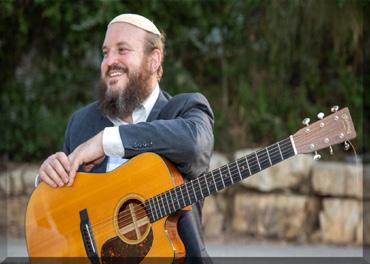





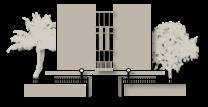



OU ISRAEL CENTER 31
BEIT KNESSET HANASSI PRESENTS AN EVENING WITH RAV SHLOMO KATZ

PROBING THE PROPHETS
BY RABBI NACHMAN (NEIL) WINKLER
Shabbat Shekalim
The Shabbat of, or before, Rosh Chodesh Adar (specifically, the Adar preceding Pesach) is designated by the G’mara in Megillah as the first of the “special” parashot that herald the arrival of Pesach. These parashot include a special Torah reading for the maftir and, consequently, a distinctive haftarah recitation from the nevi’im as well. The source of the haftarah reading is the twelfth perek of M’lachim B which relates the efforts of King Yeho’ash to repair and reinforce the weakening structure of the Beit HaMikdash.
While Ashkenazic custom focuses on the fund raising of Yeho’ash found in the twelfth chapter, Sepharadi communities begin some p’sukim earlier, at the end of the eleventh perek, where we read of the brit that the King sealed between Hashem, the King and the nation which had the people remove all remnants of idolatry from the Temple. Rav Soloveitchik explained the minhag based upon the Al Hanissim of Chanukah which first mentions that the purification of the Bet HaMikdash (“V’tiharu et mikdashecha”) preceded the kindling of the lamps (“V’hidliku neirot b’chatzrot kodshecha”) and the Temple’s rededication. In the same way, Sepharadi custom found it
essential that the haftarah first include the purification of the Bet HaMikdash before detailing the fund-raising for, and the eventual renewal of, the Mikdash.
The Rav’s grandson, HaRav Moshe Lichtenstein, offers a different –or perhaps, additional – reason for the Sepharadi minhag. He focusses upon the brit that King Yeho’ash sealed between Hashem, the King and the nation that is included in those final verses of the eleventh perek. Rav Lichtenstein points out that, before commanding the fund raising for the Mishkan (Shmot 25; 1-8), the Torah relates the brit made between Hashem and Israel (ibid 24; 7-8). Similarly, by including the earlier p’sukim, the haftarah reflects the Torah episode of Moshe establishing a covenant between Hashem and Israel before he commanded the nation to raise the necessary funds for the Mishkan,
Although these similarities create a powerful connection between Shabbat Shekalim and the actions of King Yeh’oash, it is fair to note that the maftir reading for Parashat Shekalim speaks of the obligation of the people to pay the half-shekel - while the haftarah speaks of a voluntary contributions that had no specified amount. In his work, “Netivei Nevu’ah”, Rav Lichtenstein delineates the advantages of each form of donation: Certainly, he explains, the call for unrestricted contributions would likely bring in more funds but donating a like amount from each would
32 TORAH TIDBITS 1556 / VAYAKHEL
Faculty, OU Israel Center Rabbi Winkler's popular Jewish History lectures can be viewed by visiting the OU Israel Video archive: https://www.ouisrael.org/video-library
prove that the Mikdash belonged equally to every member of Israel.
He points out that Moshe Rabbeinu’s first call for unlimited donations to construct the Mishkan reflected the passion of a generation who had experienced the divinely brought exodus, witnessed the miraculous parting of the Sea of Reeds and heard G-d’s celestial voice at Har Sinai. It was a nation imbued with an awe of Hashem and was eager to please Him. The call for contributions of indefinite amount for such a generation was more than successful – it was beyond expectations, as the Torah testifies: (Shmot 36; 7) “The effort (the funds) sufficed to complete the project…and more”.
However, the passion of that first generation could not be ensured for the future, the same commitment to building a Hashem’s “house” or generosity for supporting its daily needs was not guaranteed forever. And so, the machatzit hashekel “tax” was instituted, guaranteeing an equal share for all in the dwelling place of G-d’s shechina AND guaranteeing an ongoing source of funds for its upkeep.
King Yeho’ash was deeply committed to the task of repairing and renovating the Bet HaMikdash as we learn from his attempts to organize a “fund drive”. His concern was not the daily Temple service but the immediate repair of the edifice. As a result, he did not decree any tax on the populace. Instead [as depicted in Sefer Divrei HaYamim II (25; 5)], he sent the kohanim out to the Judean cities to actively raise the necessary funds from the citizenry. These personal entreaties to the populace made by those respected

individuals serving in the Bet HaMikdash, proved to be successful.
In conclusion, when raising funds remember the common goal of both machatzit hashekel and terumah: the involvement of all!
Simply put: only when the many remain connected can the money be collected.
Yosef Ezriel ben Chaya Michal
Chana bat Bruriah
Benzion Simcha Mendel Ben Chana Rachel
Feyge Sara bas Chaya Peshe
Nechama Charna bat Feigel
Leah Naomi bat Tova
Pesach ben Sarah Frieda
OU ISRAEL CENTER 33
המלש האופר
אנדהאב לרפ ןב עשוהי םהרבא הגלוא ןב קיזייא בל הלחמ ןב ןתנוהי

RABBI SHALOM ROSNER
Rav Kehilla, Nofei HaShemesh Maggid Shiur, Daf Yomi, OU.org Senior Ra"M, Kerem B'Yavneh
The Individual and Society
The Parshiyot of Vayakhel and Pekudei are sometimes read together and at other times, like this year, one follows the other. The word Vayakhel comes from the word ללכ which relates to the general, while Pekudei – relates to the specific טרפ.
Rav Zevin in L’Torah V’L’Moadim points out that there are two diametrically opposed world views.
SOCIETY
One where society as a whole is the main focus (ex: socialism or communism taken to an extreme), and the individual has no inherent value. Individuals can be sacrificed for the good of society. The rights of individuals can be compromised for the benefit of society as a whole.
INDIVIDUAL
The other extreme view is one that places the individual in the center. The purpose of society is to serve the individual. I decide for myself what I want to do and what is best for me, even at the expense of what is best for those around me.
Judaism rejects these two extreme approaches. As a play on the middot of interpreting the Torah טרפו טרפל ךירצ ללכ ללכל ךירצ – society is to look out for the individual and the individual is to look out for the best interests of society.
The gemara tells us one who saves a single life, it is as if they saved an entire
world. The individual is valuable and we are to do all in our power to save each and every life. At the same time, we are taught לארשי ךמעכ ימ – who is like your nation of Israel. The unit of Am Yisrael is second to none. The Torah and Hazal seem to highlight the importance of both views.
BALANCE BETWEEN INDIVIDUAL AND SOCIETY
Each star in the sky shines and is a world unto itself, yet together the stars are part of a galaxy. We need to find the proper balance of being sensitive to each and every individual and being the best we can be, while taking into consideration the needs and concerns of others in society.
During these past few months, so many people have been encountering very challenging times, yet they are able to gather the strength to perform tremendous acts of chesed for others. Individuals volunteering for miluim, sacrificing their own livelihood to defend our nation. Others opening their homes to families that have been evacuated. It is that combination of Vayakhel and Pekudei that enabled the הניכש to reside among us in the mishkan and it is what continues to serve as the key ingredient to the survival of our nation. Caring for society, while working on ourselves.
May the הניכש continue to rest among us, protect us and may we be zoche to a lasting peace in the land of Israel.
34 TORAH TIDBITS 1556 / VAYAKHEL

REBBETZIN SHIRA SMILES
Faculty, OU Israel Center
Desirable
Donations
Our parashah presents a detailed description of the materials that Benei Yisrael donated towards the construction of the mishkan and its necessities and the sacred clothing of the Kohanim. “Vayavo’u ha’anashim al hanashim kol nediv lev heivi’u…- The men came with the women; everyone whose heart motivated him brought… (Shemot 35:22). The verse’s choice of the word “al” is curious, what is the significance here and how is it applicable to us today?
Onkelos interprets the verse to mean that the men brought the women adorned with their jewelry which they removed and donated to the Mishkan. Rav Moshe Feinstein in Darash Moshe expounds - the women showed how beloved their jewelry was to them, nevertheless donating it to the Mishkan was an even more special cause. When one gives something precious to a distinctive enterprise, the donation is elevated to a higher level.
Rabbeinu Bachaye explains that the women were already there when the men came to donate. Their zerizut was such that they preempted the men in giving. This is especially significant since the women did not give their jewelry to participate in the
sin of the golden calf. The greatness of the women is alluded to in the following verse, “Asher od biksha nafshi ve’lo matzati adam elef mei’echad matzati, ve’isha bechol eleh lo matzati - Which my soul sought yet, but I did not find; one man out of a thousand I found, but a woman among all these I did not find.” (Kohelet 7;28) “These” echoes the words said as the Jewish people created the golden calf, “Elah elohecha Yisrael! – These are your gods, Israel!” (Shemot32:4), among which no women were found! As a reward, women received the celebration of Rosh Chodesh which had originally been given to the men, specifically to the twelve tribes. In celebrating Rosh Chodesh, women are reminded of their passionate dedication to Hashem and reinforce its priority.
The Chidushei Harim, Rebbe of Gur, offers a beautiful Chassidic interpretation. When the men donated their gold to the Mishkan they manifested a “teshuvat hamishkal.” They found themselves in a similar situation to that of the sin of the golden calf however, this time they responded positively and donated to a holy endeavor. Since the women did not sin in donating to the calf, they did not need this teshuvah. Chazal teach us that those who sin and repent are (in certain respects) on a higher level than those who never sinned. It is harder to admit that one made a mistake and try to make amends than never to have fallen in the first place.
36 TORAH TIDBITS 1556 / VAYAKHEL
Hence, our verse is telling us that the men were al - above the women in this case, since they were baalei teshuvah who were rectifying their sin.
The Torah, therefore, is praising both the

“Personal Experience with Gedolei Torah on Medicine and Halacha”
Drasha after Mussaf followed by a Kiddush and Question & Answer session on Medicine and Halacha
“War in Light of Halacha: Spiritual Resilience for the IDF and Am Israel”
All Welcome to Attend ‧ Free of Charge ‧


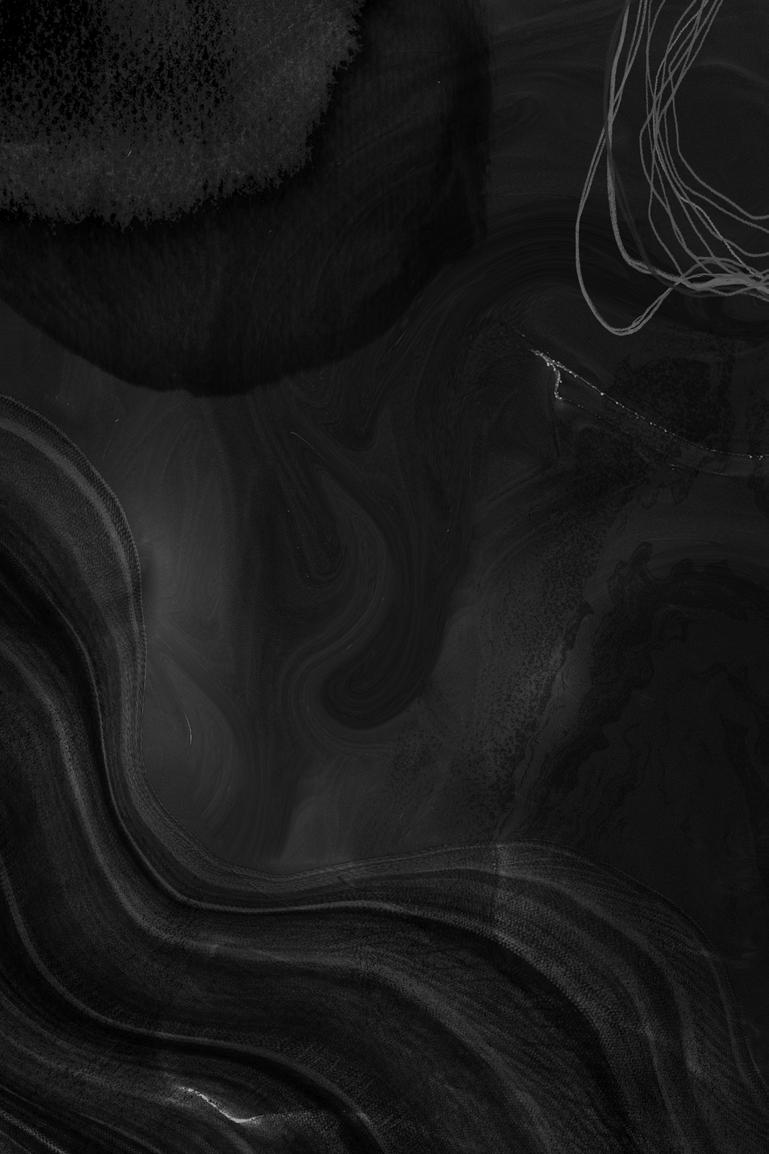






TORAH TIDBITS 1556 / VAYAKHEL J O I N A T E A M T H A T W I L L P R E P A R E T H E G I F T S H E L P U S D E L I V E R M I S H L O A C H M A N O T T H R O U G H O U T T H E C O U N T R Y PROVIDING SUPPORT TO 4500 TERROR VICTIM FAMILIES C H A V I V A : 0 5 4 - 6 6 4 4 1 8 6 W W W . O N E F A M I L Y T O G E T H E R . O R G I N F O @ O N E F A M I L Y F U N D . O R G B r i n g t h e s p i r i t o f P u r i m i n t h e f o r m o f M i s h l o a c h M a n o t t o f a m i l i e s a n d v i c t i m s o f t e r r o r t h r o u g h o u t I s r a e l . S P O N S O R T H E S E G I F T S 3 W A Y S Y O U C A N P A R T I C I P A T E : Help us spread the joy of Purim Beating the banks every time
be in loving memory and
our dear parents whose yahrtzeits are in Kislev
been memorialized in a popular song, "An eternal people does not fear the long and arduous path."
Doris Weinberger a"h
ולסכ 'ד -ה"ע המלש לאקזחי תב האל הרובד
Max Weinberger z”l
ולסכ ז"כ -ל"ז בד ןב ךלמילא
Greatly missed by their children, grandchildren and great grandchildren
Rav Aryeh and Dvora Weinberger
Bernie and Leah Weinberger
Menachem and Hannah Katten
Patience is necessary for those who follow Isaac's way. But a wise woman taught us that patience is but another name for hope. That woman was Jane Austen, who put these words into the mouth of one of the characters in her great novel, Sense and Sensibility: "Know your own happiness. You want nothing but patience—or give it a more fascinating name: call it hope."
In observance of the Shloshim of our friend Yehuda Leib Berren z"l
Rav Menachem Weinberg will give a shiur in his memory "Heroic Joy"
Monday evening, 23 November/ 8 Kislev 7:30pm

Zoom Meeting: 853 8980 1519
Password: Yehuda
SEALING SERVICES

shmuelnathan4@gmail.com

OU ISRAEL CENTER 39 OU ISRAEL CENTER 15
052-385-9944 • 054-499-9043
נ
על
"



42 TORAH TIDBITS 1556 / VAYAKHEL




OU ISRAEL CENTER 43 Especially Now! Donate through our website www.ouisrael.org/purim Give Pre-Purim Mishloach Manot to heroic IDF soldiers in bases and in hospitals Price: $28 / NIS 100 רעונה יזכרמ םוקמ אתיירואד or scan the code Donations made to the OU Israel are tax deductible Join OUr Purim Campaign


44 TORAH TIDBITS 1556 / VAYAKHEL
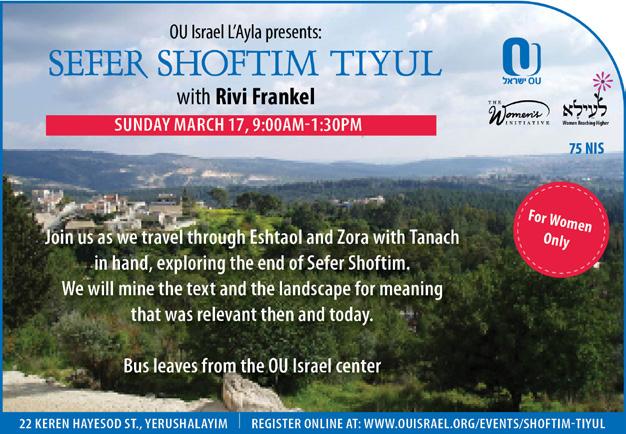

OU ISRAEL CENTER 45
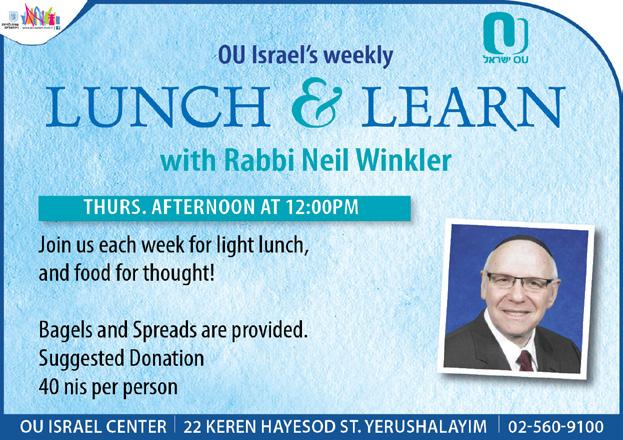

46 TORAH TIDBITS 1556 / VAYAKHEL


OU ISRAEL CENTER 47
Before receiving the Torah at Mount Sinai, there were some Israelites that, of their own accord, already kept the entire Torah. Since this is the case, why is this day so important?

On the day of Matan Torah 2 things changed. Firstly the Jews gained a connection to Hashem. Hashem put his essence into the Torah so when he gave it to us both those that had and had not kept the Torah before were now keeping it because of this connection to Hashem’s essence.

Secondly, the Torah given at Mount Sinai is able to have an effect on the physical world whereas before Torah and mitzvot were considered strictly spiritual matters.

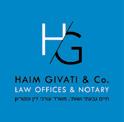
The Talmud (Shabbat 88b) states that when the Jews heard G-D’s divine voice, they all died from its intensity and afterwards G-d brought them back to life. I think this emphasizes why Hashem cannot be openly present in this world. For if he was, the Jews’ free will would no longer be preserved and we would follow Hashem in everything. If his awe and will were so apparent, we would be compelled to follow him without having a real choice.
ing college students and young professionals.
JLIC Israel’s goals include: building a warm and welcoming Jewish community for students and young professionals; providing engaging and dynamic Jewish education; providing a supportive home environment for Olim; providing resources for personal and religious growth, including personal mentoring, Aliyah support, religious guidance and leadership development. Current JLIC programs in Israel include: Reichman University - Herzliya; Bar Ilan University - Givat Shmuel; Tel Aviv University; Tel Aviv for Young Professionals; and Jerusalem. Contact: Rabbi Jonathan Shulman, Director of OU-JLIC in Israel shulmanj@ou.org


JLIC at Tel Aviv University does amazing work in bringing Jews together and teaching us all about the torah we received at Mount Sinai. JLIC, I believe, helps us



48 TORAH TIDBITS 1556 / VAYAKHEL
DOROT - The OU Women's Intergenerational Choir Director Hadassah
052-384-7230 Monday Evenings
Call to check OU ISRAEL CENTER 91
proud sponsors
Jacob
7:00-9:00pm
communities in Israel to support English-speak-
For Sale: Ben Maimon, 4 rooms, 113m, 2 bathrooms, porch, 1st floor, elevator, 6.2 million NIS Smadar 050-3114040 // 02-642-4329 smadi_bida@walla.co.il PRI HADASH WOMEN'S WRITING WORKSHOP AT THE OU ISRAEL CENTER Monday mornings 10.30-12.30 For more details, call Ruth 02-628-7359 or Judy 054-569-0410 Call to check Tuesday PLEASE NOTE TORAH TIDBITS ADVERTSING THROUGH PURIM Shabbat March 15-16 » Deadline Sunday, March 10 Shabbat March 22-23 » Deadline Sunday, March 17 Shabbat March 29-30 » Deadline Thursday morning, March 21 at 11am (no guarantee that ads received after this time will go in)
SHIUR
TO SPONSOR A SHIUR CONTACT
Chana Spivack - 050-229-4951 or donate online: https://www.ouisrael.org/donate/ou-israel-center/
RABBI SHAI FINKELSTEIN'S SHIUR
is sponsored for this academic year by the Sondhelm and Wertenteil families in memory of Mel David z"l ל"ז הקבר אביוטו ריאמ םהרבא ןב לדנמ םחנמ
RABBI ADLER’S SHIUR
is sponsored for this academic year by the Frist family in memory of their beloved daughter and sister Elisheva Frist a"h - ה"ע ןמלז תב אמיס עבשילא
RABBI GOLDSCHEIDER'S SHIUR
was sponsored for this Academic Year תמשנ וליעל ל''ז המלש ןב בוט םשו ה''ע םהרבא תב םירמ
REBBETZIN SHIRA SMILES SHIUR
was sponsored for this academic year by Dr. & Mrs. Menachem Marcus in memory of their parents, Rose & Dr. Emanuel Marcus z"l and Rosi & Ernest Strauss z"l
ל"ז סוקרמ השמ ןב יכדרמו ריאמ ףסוי תב לזייר
ל"ז סוארטש דוד ןב לאינדו םהרבא תב דומיל
RABBI BREITOWITZ'S TUESDAY SHIUR - MINCHAT CHINUCH is sponsored for this academic year by in memory of their parents
ד"יה לאפר תב ה"ע רתסאו ל"ז קודצ ןב הנוי and their son Rabbi Shmuel Eliyahu Auman z"l
י"נ לאפר ברה ןב ל"ז והילא לאומש ברה
RABBI GOLDIN'S SHIUR
was sponsored for this academic year by in memory of beloved aunts Irma Haas a"h and Hilde Myer a"h
RABBI MANNING'S SHIUR
was sponsored for this academic year
ל''ז ןמלק ןב גילזו ה''ע תידנרב תב הנרב

for an
AM YISRAEL

RABBI TAUB'S WEEKLY THURSDAY PARSHAT HASHAVUA SHIUR is sponsored by The Jewish Legacy Foundation





OU ISRAEL CENTER 49 Torah Tidbits distribution is looking for the right connection to help get TT to TZFAT and KARMIEL each week Call Toni at 0505-772-111 המלש האופר הניאר תב הרוא GET FIT WHILE YOU SIT: Exercise for ladies Sundays 12:45-1:30pm at the OU Israel Center Sura Faecher 0504153239 Resumes Oct 15th 12:30-1:15pm
SPONSORS

RABBI JUDAH MISCHEL
Gather!
At a Rabbinic convention in St. Petersburg, a very wealthy gevir, known for his open-hearted support of Torah institutions, approached the Chofetz Chaim, Rav Yisroel Meir haKohen. While he had been a consistent donor to the yeshivah in Radin and contributed to many causes that the Chofetz Chaim took responsibility for over the years, he had never been privileged to meet the renowned gadol in person. He approached the rav with humility and awe, and asked for a blessing for parnassah and success.
The Chofetz Chaim looked up, grabbed the donor’s hand and said, “Oy! What a pity that this generous hand is mechalel Shabbos! How sad that it desecrates the holy day!”
The respected sage held onto his hand, looked pleadingly into his eyes, and began to cry.
The donor began to cry as well. “I want to do teshuvah,” he blurted, “I would love to keep Shabbos! But please… I have so many responsibilities, so many people are counting on me! Please allow me to work just one last Shabbos so that I may close up shop and tie up my affairs before moving forward….”
“If Shabbos were mine, I would permit it!” answered the Chofetz Chaim. “But it belongs to the Ribbono Shel Olam and to Klal Yisrael… So no, I will not permit its
desecration — not even one moment of Shabbos!”
רמאֹיו לארשי ינב תדע־לכ־תא השמ להקיו :םתא ת�ש על ׳ה הוצ־רשא םירבדה הלא םהלא היהי יעיב �� שה םֹויבו הכאלמ השעת םימי תשש הכאלמ וב השעה־לכ ׳הל ןֹותבש תבש �ש דק םכל :תמוי
Moses then gathered the whole Israelite community and said to them: These are the things that Hashem has commanded you to do: On six days work may be done, but on the seventh day you shall have a Sabbath of complete rest, holy to Hashem; whoever does any work on it shall be put to death. (Shemos, 35:1-2)
The name of this week’s sedra, Vayakhel, “And he gathered,” frames the primary mitzvah and focus of the reading. Moshe Rabbeinu assembles Klal Yisrael and reinforces Shabbos as the backbone of our relationship with Hashem. As an illustration of the foundational nature of Shabbos, consider the juxtaposition between the commandment to observe Shabbos and the instructions for the construction of the Mishkan, Hashem’s home among us.
Rav Yehoshua Neuwirth, zt’l, is the renowned author of the classic Shemiras Shabbos k’Hilchasah, a multi-volume work addressing a wide range of halachic aspects of Shabbos observance. His father served as the rabbi of major congregations in Berlin and Mainz, before the War, and
50 TORAH TIDBITS 1556 / VAYAKHEL
Executive Director, Camp HASC Author of Baderech: Along the Path of Teshuva (Mosaica 2021)
then, through a series of incredible miracles, most of the family survived the Shoah by hiding in Amsterdam. In 1946, as a teenager, Rav Yehoshua fled to the Holy Land.
As migrating to Pre-State Israel was illegal, the organizers of the effort told Rav Neuwirth that his boat had to leave on Shabbos. While such a ‘Shabbos journey’ was technically justified due to pikuach nefesh, Rav Neuwirth promised himself that if he would make it to Eretz Yisrael, he would commit himself to doing something to glorify Shabbos observance. His masterpiece, addressing contemporary laws of Shabbos, was the fulfillment of that promise.
Upon arriving in Yerushalayim, Rav Neuwirth studied at Yeshivas Kol Torah, and established a close, lifelong relationship with Rav Shlomo Zalman Auerbach, one of the respected Gedolei haDor, whose piskei halacha are featured throughout Shemiras Shabbos k’Hilchasah.
In the introduction to the new printing of the sefer, Rav Neuwirth shares an insight pertinent to the parshah. Of all the mitzvos in the Torah, Shabbos is the only commandment that is introduced with the term Vayakhel — from the same root as kehilah, ‘gathering’ or ‘community’. While there are many mitzvos in Torah that have a communal, public component, in order for Shabbos to be observed in its intended form, it must be fulfilled, celebrated and experienced within a community. While much of religious life is expressed communally, the Torah defines Shabbos in this way. It is לארשי ינב ןיבו יניב, “Between Me, and between the Children Israel….”
להקיו: Today, just as in the Mishkan,
Shabbos gathers together all of Am Yisrael, welcoming us into a shared, intimate meeting with Hashem. With work being forbidden, hierarchy is dissolved; social status and all external metrics of power, influence and success, are irrelevant in this ‘sanctuary in time’. There is no ‘getting ahead’, no competing with others — nor even speaking of the workday world which seems to divide us into professions, labels or classes.
All of this allows us to orient our attention toward our inner world, and toward community, our closeness with others. As in the Mishkan, we are to be consciously ‘before Hashem’ in d’veykus, closeness to God. In this world of the spirit, all are ‘friends and family’.
On this Shabbos, we gather also to read the maftir of Shekalim, the contribution of the half shekel. Each of us individually are but one ‘half’; we are built to gather in one another and to form ‘wholenesses’ between every other member of this vast family. May we answer the great call to unity and togetherness, and fulfill the plea of the righteous heroine, Esther haMalkah: Lech, k’nos kol haYehudim, “Go, gather together all the Jews!”.


ARNONA:
BAKA:
RECHAVIA: 4-room apartment, 92m, Suka balcony, Shabbat elevator, fully accessible, private parking, storage
OU ISRAEL CENTER 51
Meir Golan
golanechasim@gmail.com Meir Golan Old Katamon: 4-room apartment in a small and quiet street, 101 sqm, renovated, very bright and airy, master bedroom, Safe room (mamad), sukkah balcony, view, elevator, 3,400,000 NIS Old Katamon: 4-room apartment, 90 sqm, well split, bright airy, sukkah balcony facing a magnificent panoramic view, 3 exp Shabbat elevator, parking, 3,290,000 NIS Old Katamon: Spacious 3-room apartment in a very quiet street, 75 sqm, sukkah balcony facing a green and pastoral view, 3 exp. Shabbat elevator, private parking, storeroom, 2,690,000 NIS RASCO: new 4 room apartment, 95m, master suite, elevator, balcony, very nice view 2,950,000 NIS
077-2050015 052-2678749
beautifully
master suite, balcony, storage, Shabbat elevator, private parking 3,250,000 NIS
4-room apartment, 90m,
renovated,
New 4
apartment
master
room
in a new building, 88m,
suite, storage, Shabbat elevator, private parking, 3,950,000 NIS
4,400,000 NIS NEW BUILDING for SALE in RECHAVIA, JERUSALEM
a variety of
rooms, garden apartments & penthouses, high standard,
parking & storage for each
Suitable
a
family/community
Includes
3-6
Shabbat elevator,
apt.
for
large

SIMCHAT SHMUEL
BY RABBI SAM SHOR Program Director, OU Israel Center
This Shabbat, we will read Parshat Shekalim, one of the four special parshiyot which link together the days of Adar- beginning this coming week with Rosh Chodesh Adar, with the days of Nisan, leading up to Pesach.
Each of these four special parshiyot, introduces us to important, eternally relevant messages.
Parshat Shekalim begins with these familiar verses:
This is what everyone who is entered in the records shall contribute; a half-shekel to the Mishkan by weight—twenty gerahs to the shekel—a half-shekel as an offering to Hashem.
Everyone who is entered in the records, from the age of twenty years of age and above, shall give an offering to Hashem:
The wealthy shall not pay more and the poor shall not pay less than half a shekel when giving the offering to Hashem as atonement for each of you.
The Chasidic Masters suggest many important messages inherent within this mitzvah.
The Toldot Yaakov Yosef, Rebbe Yaakov Yosef of Polnoye zy’a, explained that each person must give exactly a half shekel to instill within us that no one individual is truly complete or fulfilled as a lone individual, that it is only through coming together with others and helping one another, that we truly feel complete.
Similarly, the Avodat Elazar of Kozhnitz zy’a, points out that even one who has
great wealth, must bring only the same half shekel, as one who is impoverished, as if to teach each of us, that no matter our means, none of us is truly complete, as an individual-we are only truly whole, when we join together with the rest of Klal Yisrael.
Taking this idea a step further, the Birkat Avraham of Slonim, zy’a points to a well known Talmudic teaching in Masechet Kiddushin 40b:
A person must always consider as if they are half meritorious and half liable. WIth one ma’ase mitzvah, they bring themselves and the entire world to the side of merit...:
The Birkat Avraham, explains that this gemara is teaching us the fundamental lesson of the mitzvah of machatzit hashekel. The Rebbe explains, that not only are we as individuals only truly whole when we join together and contribute to the enterprise of the Mishkan, but in doing so, we are simultaneously reminded of the capacity each and every one of us has to be a conduit for good, to grow and improve as individuals, and that in so doing each one of us is simultaneously contributing to the betterment of the entire world.
Yehi Ratzon, on this Shabbat Shekalim, may we find chizuk in these powerful teachings from these great Chasidic Masters, and may we merit to look out for and give to one another, and continue to lift up one another and the entire world through our mitzvot and maasim tovim. Chodesh Tov!
52 TORAH TIDBITS 1556 / VAYAKHEL



OU ISRAEL CENTER 53 Hachnassat Kalla - YAD GITTEL Get your trousseau (nedunya) at COST PRICE For more details call 0523882751 or Sonia 0528066664 yadgitteltrudy@gmail.com Meet EZwill – your online Will creation service! Visit www.ezwill.co.il and finally get it done! Still haven’t taken care of writing your Will? Simple & secure Affordable Step-by-step guide Option for Halachic addendum Created and supported by an Anglo-Israeli lawyer with 15+ years experience

GEULAS YISRAEL
BY RABBI MOSHE TARAGIN R am, Yeshivat Har Etzion
The Second Time Around
The physical construction of the mishkan was executed by a select team of artisans, craftsmen, and engineers. Most of the general populace had little direct involvement with the building process. After donating the raw materials for the mishkan they stepped aside, allowing the professionals to complete the project.
It is surprising then, that the Torah describes the various dimensions and contours of the mishkan in such precise detail. These specs were only relevant to a handful of people tasked with the actual construction and manufacturing process. It is odd that the Torah provides such meticulous details which were only relevant for a tiny percentage of the population.
It is even more peculiar that the Torah repeats this enormous list of details a second time, in Parshat Vayakhel. In general, the Torah economizes its words, and, in this instance, it could have easily crunched the entire construction story into a few sentences. The Torah could have summarized the entire parsha by writing “All the materials were collected and handed to the craftsmen who then fashioned the mishkan as Hashem had earlier instructed”. Why does the Torah expound such complicated details a second time? Isn’t one round enough?
THE BRIDE AND GROOM AND THEIR FURNITURE
A little over 20 years ago, my revered Rebbe U’Mori, Harav Aharon Lichtenstein delivered a legendary speech addressing this riddle. He spun an enchanting story to illustrate the reason for the Torah’s verbosity.
He told the story of a groom and a bride visiting a store, a few days before their wedding, to select furnishings for their new home. They strolled leisurely through the store, patiently considering each furniture option. Their relaxed pace stemmed from the fact that, for them, selection of furniture wasn’t just a logistical or practical issue. Each furnishing evoked their hopes and dreams for their future. As they chose dining room furniture, they imagined it decked out for Shabbat and surrounded by family. As they selected kitchen furnishings, they dreamed of preparing food for guests. As they chose their bedroom furniture, they envisioned the many private moments they would spend together. Each decision and each selection was a labor of love. The furniture was ordered and stored, in anticipation of the wedding day.
Shockingly, the night before the wedding the bride betrayed her husband. The next day the appalling news broke, and the entire wedding disintegrated into anger and vitriol, as both families stormed out
54 TORAH TIDBITS 1556 / VAYAKHEL
YISRAEL
of the wedding hall in outrage. Realizing that his marriage was doomed, the groom contacted the furniture store to cancel the furniture order.
For months the two parties didn’t speak. At some point though, a relative of the bride contacted the groom, pleading with him to consider a possible rapprochement. At first, he was horrified by the notion, but ultimately, he agreed, hesitatingly, to meet the woman who had so deeply insulted him. Though at first it was extremely awkward, ultimately, they agreed to reunite, and, after many meetings, the wedding was rescheduled.
A few days prior to the wedding the groom and bride returned to the furniture store to select new furniture. This time, however, every selection was cloaked with pain and anguish. Instead of the love and anticipation which had sparked their initial visit they were now haunted by suspicion and distrust. They had little appetite for leisurely selections but instead made hurried decisions, ordering whatever floor models were available. The selection of furniture was now emotionally burdensome and laborious. They had little desire for details.
RESTORING INNOCENCE
Human beings can forgive each other but can rarely remove the scars of past wounds. We can summon generosity of spirit and forgive those who injured us, but the pain rarely disappears. Even after forgiveness, the relationship is rarely the same. After it heals, it still hurts.
Hashem is different. He promises that, after forgiveness, we can return to our original state of innocence. The bold announcement of םדקכ ונימי שדח invites us to return to our original state of purity,







prior to our religious breakdown.
The betrayed husband forgave his wife, but their relationship would never be the same. He could not select furniture with the same enthusiasm he once felt. By contrast Hashem, our Husband, reboots our relationship “just as it was”. His “excitement” about the mishkan and its furniture is just as enthusiastic as it was prior to the debacle of the egel. The lengthy repetition of mishkan details in Vayakhel emphasizes that Hashem forgave us as if the egel betrayal never occurred. The details “matter” to Him now, just as they did before.
The first of the 13 attributes of mercy or the םימחרה תודימ ג”י is the phrase containing the repeated twice ’ה ’ה. According to the gemara in Rosh Hashanah (17b) the repetition of the exact same word indicates that Hashem has mercy for us both before and after our sins.
OU ISRAEL CENTER 55 NEW OFFER PRE-SALE IN OLD KATAMON Whatsapp +972 (0) 52-2636656 usa# 5164675892 , uk# 2037697899 AN EXCEPTIONAL AND RARE OFFERING TO PURCHASE LAND TO BUILD A SINGLE OR SHARED FAMILY HOME IN A BRAND-NEW BUILDING 1-5 BEDROOMS APARTMENT, ONLY 13 UNITS AVALIABLE - 2.45M NIS CREATE YOUR DREAM HOUSE IN THE GERMAN COLONY For more offers more Call now: 077-9973185 ONLY 5 NEW APARTMENTS AVALIABLE - 16 MONTH TO COMPL ITION NEW OFFER IN ARNONA - IN THE OLD SOUHGT AFTER PART Gershon Agron 24, Mamilla - Jerusalem PRIVATE INQUIRIES ONLY BUILD YOUR HOME IN BAKA , LARGE PLOT FOR 3 FAMILIES ,Private inquiries only!! NEW OFFER
Namely, teshuvah resets our relationship to the exact same pre-sin condition, with the exact same tone and tenor. The very same word which describes divine mercy prior to sin, depicts divine mercy after sin.
The repetition of details in Vayakhel is Hashem’s way of signaling that He loves us as deeply as He did before our betrayal. The details of our home and the dimensions of our furniture are just as endearing to Him now as they were before. We returned to innocence.
HISTORICAL REBOOT
What is true about our religious relationship with Hashem is also true about our historical relationship with Him. The midrash (Eichah Rabbah 5) cites two interpretations about the word םדקכ, effectively presenting two different “earlier” stages in history which we yearn for. According to one interpretation we yearn to return to the condition of Adam Harishon prior to his sin. We seek to reset our relationship with Hashem to the original pristine state of Man prior to original sin. We seek a religious reboot.
However, the second version of the midrash claims that we seek a restoration of the days of Shlomo Hamelech. Namely we seek historical restoration not a religious reboot. We long for a return to Jewish sovereignty and to Jewish monarchy.
The End of The Innocence
On October 7th we lost our historical innocence. This dark day shattered so many previously held conceptions. This historical rupture altered the manner in which we processed our return to Israel. Before this tragedy, we viewed our return to our homeland with unbridled optimism. Prophecies were materializing before our eyes and the graph
of Jewish history was surging upward. It seemed as if the tables of history had turned, as we witnessed the level of divine hashgacha which had been obscured for so many gloomy centuries of Jewish exile. We thought we had left the era of םינפ רתסה behind, and were sauntering toward redemption. We felt a boy-like enthusiasm about our future under Hashem’s redemptive care.
October 7th reminded us of just how far we still need to go. It shattered our conception of history. We are no longer as innocent and even naïve as we were beforehand. The massacre sobered us with a heavy dose of realism. In the immediate sense, the redemptive process doesn’t appear to be as smooth as we had anticipated. Our pride at returning to Israel has been enveloped in heartache and sadness.
In the aftermath of this tragedy, can we reset our historical outlook to its original state? Can we feel the same rush of optimism, even though we suffered such a breakdown. Can we renew our enthusiasm to its October 6th condition? Can we blend optimism with realism? Hashem expects us to. He wants us to view this process of returning םדקכ , just as we viewed it before. We are no longer naïve and no longer giddy. That doesn’t mean we aren’t faithful and optimistic.
לארשי יפלא תובבר ’ה הבוש
We pray for the safe return of hundreds of hostages, tens of thousands of soldiers and hundreds of thousands of displaced Jews to their homes.
םדקכ ונימי שדח
We pray that Hashem quickly resets our condition in Israel. We hope that after the fall, we are able to reboot it in our imaginations as well.
56 TORAH TIDBITS 1556 / VAYAKHEL


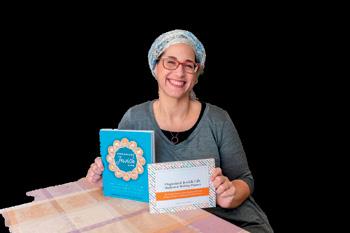


OU ISRAEL CENTER 57 be ready for every thing Pick up your copy and be prepared for every occasion and Jewish life cycle event. Checklists to help you prepare for every event @BALAGANBEGONE organizedjewishlife.com Companion Shabbat & Holiday Planner online at amazon.com or in Israel exclusively at Makes a great gift

 BY REBBETZIN DR. ADINA SHMIDMAN
BY REBBETZIN DR. ADINA SHMIDMAN
The First Tzedakah Box
PARSHAT SHEKALIM - MELACHIM II
12:1-17
How do you run a successful fundraising campaign? During the time of evil Queen Atalia, the Beit Hamikdash fell into a state of disrepair. Her righteous son Yoash turned to the people to donate money after the funds of the Kohanim were not enough to sustain the repairs. His campaign was highly successful and the funds were raised to repair and reconstruct the Beit Hamikdash. What was it that made his campaign successful?
Divrei Hayamim II highlights the people’s generosity in the time of Yoash and describes the monies as given with great joy and abundance. This description was also used to describe King David’s original efforts many years earlier to raise money for the building of the Beit Hamikdash. The posuk in Divrei Hayamim I states, וחמשיו הל ובדנתה םלש בלב יכ םבדנתה־לע םעה, the people rejoiced in their donations, for they donated wholeheartedly to Hashem.
King David expresses his awe of the peo ple’s contributions and says to Hashem, םלועל תאֹז־הרמ�ש, preserve this (spirit of gen erosity) forever. We recite these words from the end of Divrei Hayamim in the Tefillah of ןויצל אבו. Rav Pam z”tl explains that King David recognized that there may be a time when people will be asked to contribute
and may not respond as generously as during the Beit Hamikdash fundraising campaign. Perhaps the marketing won’t be as slick, the cause not as compelling, the need not as well expressed. King David asks Hashem to take some of the “preserved” simcha of giving from his Beit Hamikdash building campaign and to bestow it on the people of future generations so that they too may know the joy of giving and supporting others with an open heart.
This Haftorah of Parshat Shekalim introduces the Purim and Pesach season when we are called upon to give generously to support those in our community who are in need. May we indeed merit to give with joy and warmth, recognizing that it is a privilege to give Tzedakah and help our fellow man.



58 TORAH TIDBITS 1556 / VAYAKHEL HAFTORAH
INSIGHTS
053-‐427-‐6363
CITY
MALL,
JERUSALEM ArthurMSamuels@gmail.com PODIATRIST Over
30
years
experience Arthur
Samuels,
DPM Licensed in Israel & America
CINEMA
CITY MALL, JERUSALEM
CINEMA
Purim Themed Tours • Public & Private Tours

Nachliel knows his stuff…he can create a unique blend of the ancient and the modern, as he tickles your imagination at the Met. A deep, impressive dive into Jewish History. Dive in!
- Rabbi David Fohrman

I strongly recommend and encourage everyone to join Nachliel Selavan “The Museum Guy”...we are all walking out with not only a renewed appreciation of Tanach, but appreciating the civilizations, the symbols, the meaning behind them, that help bring Tanach to life...
- Rabbanit Shani Taragin
by Nachliel Selavan M.Ed “The Museum Guy”
10% discount coupon:
PURIMvirtual10


OU ISRAEL CENTER 59
of the
• Israel Museum • Bible Lands Museum • Virtual Tours
Persian Empire
• Israel Museum • Bible Lands Museum • www.museumtours.co.il 054-452-0209
For more information & registration: WWW.NBN.ORG.IL/CONVERSATIONS Every Monday | 8PM (1PM EST) | On Zoom Conversation-based Hebrew classes online! Learn Hebrew with NBN! Conversations
Bills ToDo: Forms
Don't let Hebrew get in your way!
Every Tuesday | 10AM-2PM | NBN Aliyah Campus
Translation Tuesdays goes beyond basic translations. Our dedicated NBN staff offer one-on-one assistance to help you navigate and understand any challenging Hebrew task.
For more information & registration: WWW.NBN.ORG.IL/TRANSLATIONS Weekly events available for all!
Translation
Tuesdays

RABBI AARON GOLDSCHEIDER
EDITOR, TORAH TIDBITS
EDITOR, TORAH TIDBITS RAV, THE JERUSALEM SHUL - BAKA, JERUSALEM
Completing the Half-Shekel
On the first of the four special Shabbatot, which oftentimes coincides with Parashat Vayakhel, we read Parashat Shekalim. This is to commemorate the ancient practice of the Temple era, during which a collection was taken at this time of year, the beginning of Adar, to fund the purchase of sacrifices for the coming season.1 Why was the half-shekel given specifically at this time of the year? The Talmud says it was to preempt a terrible event that would occur in Adar:
Reish Lakish said: It was revealed and known before the One who spoke the world into existence that Haman would weigh out shekels for Israel[‘s destruction]. Therefore, He preceded their shekels to his shekels. And this is what we learn, “On the first of Adar, they make announcements about the shekels.”2

attacking the Jews because the Jewish people exhibited disunity. Haman said to Achashverosh: “there is a certain people who are scattered and separated” )דרפמו רזפמ דחא םע ֹו נשי( (Esther 3:8)they were a unified people )דחא םע( but now they are an aggregate of individuals )דרפמו רזפמ(. He mistakenly believed that the divine protection afforded the Jewish people was reduced in their exilic dispersion. But Queen Esther believed in the unity embedded within the heart of the nation, “Go gather )סֹונכ( all the Jews” (Esther 4:16). The term keneset Yisra’el )לארשי תסנכ(, the assembly of Israel, reflects the closeness and unity of the Jewish people.
What is the connection between Haman and the giving of the half-shekel?
In a lengthy discourse,3 Rav Avraham Yitzchak Hakohen Kook explained that Haman thought the time was ripe for
1. Mishnah, Shekalim, 1:1.
2. Megilah 12b.
3. The presentation below is based on Midbar Shur, derush 15.
The half-shekel given each year to the Temple was a tangible symbol of the special brotherhood and unity of the Jewish people. Members of other nations cooperate to attain individual success. Without social order, no one’s prosperity (let alone security) is assured. But the fellowship of the Jewish people is not motivated by practical considerations such as these. Jewish unity is directed toward the nation’s highest aspiration, drawing down God’s
62 TORAH TIDBITS 1556 / VAYAKHEL
presence into our midst. Only when there is peace can God live among us. When the half-shekel was collected for the very first time in the wilderness, the silver was used to make sockets for the pillars of the Mishkan. Collectively, these formed the foundation for the place God would call home, as it were, on earth. Therefore, the half-shekel had to be given by all, as a token of Jewish unity. The annual donation of the halfshekel demonstrated our ongoing unity and commitment to keeping it that way. Hamans of the world should take note and not think otherwise.
Why a half-shekel instead of a whole shekel? Rabbi Shlomo ha-Levi Alkabetz reportedly said that it represents the fact that every Jew is only half a person and is made whole when joining hands with brothers.4 Rabbi Elazar Rokeach of Amsterdam quoted commentators who note that the Hebrew word for shekel (430 = לקש) is numerologically equivalent to the word for soul (430 = �ש פנ).5 Therefore, when one gives a half-shekel, it can be said to signify that we are only offering half of our soul, since we need to bond with our fellow Jews to complete our souls. The half-shekel is all about unity.
According to the Torah, the small coin was intended to atone for one’s soul (Exodus 30:12). Overindulgence in our personal aspirations and achievements, at the expense of our people, is a transgression that requires atonement. Giving the half-shekel, becoming more selfless and
4. Quoted in Torat Moshe on Exodus 30:13.
5. Ma’aseh Roke’ach al ha-Mishnah, Seder Mo’ed, Shekalim.
identifying more with our people, affects this. Even today, without a Temple and the donation of half-shekels, the personal atonement and sustainment of national unity continues. The public reading of parashat Shekalim, Rav Kook says, awakens a desire to draw closer to our fellow Jew, which in turn brings us into greater proximity with our Creator.
The Arizal introduced an intention to be recited and meditated upon before beginning the morning prayers every day: “I hereby take upon myself the fulfillment of the mitzvah to ‘love your neighbor as yourself’ (Leviticus 19:18).” With Rav Kook’s teaching in mind, we can fully appreciate the significance of intentionally seeking brotherhood and unity before prayer. It is not merely a convenient place to express this sentiment. Prior to appearing before the Almighty in prayer, we take a moment to recognize that we can only stand in His presence when our people are one.
In some liturgical rites, the same sentiment appears towards the conclusion of our prayers. “For the sake of my brothers and friends, I speak for your peace. For the sake of the House of the Lord, our God, I request good for you” (Psalms 122:8-9). These verses link brotherly love with the Temple, the place of God’s presence. Harmony is essential in order to experience
OU ISRAEL CENTER 63 Carmei Gat’s expert Anglo agent Exclusively selling a rare garden home 4 bedrooms, 3 bathrooms, kosher kitchen, 1 minute walk to Anglo Shul Email: debisraelhomes@gmail.com Whatsapp: 0532852345
God’s immanence.
This is true even outside the house of God. Rabbi Shlomo Zalman Auerbach was a rosh yeshivah in Jerusalem and one of the outstanding rabbinic personalities of his generation. A student once gave him a ride back to his home from the yeshiva and noticed that when the rabbi got out of the car to enter his home, he would pause to brush off his jacket and straighten his tie before entering. “Now that the day is over and you are going home, why are you concerned about your appearance?” asked the student. The great rabbi answered: “I am about to enter my home. The Gemara says that in a home where there is peace, God’s presence resides.6 I am about to stand before the Shechinah. I want to enter my home in the most respectful manner knowing this is where God dwells.”
Wherever there is harmony, there God can be found.
6. See Sotah 17a.
Rabbi Goldscheider is the author of the newly published book ‘Torah United’ (OU Press), featuring divrei Torah on the weekly parasha from Rav Kook, Rabbi Solovetichik, and the Chassidic Masters.



64 TORAH TIDBITS 1556 / VAYAKHEL
FOLDING CHAIRS WWW.FOLDEES.CO.IL | 058-707-8181 • STYLE & COMFORT
MANY COLORS & DESIGNS
FAST DELIVERY HIGH QUALITY PREMIUM URGENT TZEDAKKAH APPEAL Very ill widow woman with no family, cancer survivor etc.., desperately needs money for basic needs, medical expenses, and a place to live. Endorsed by Rabbonim, Badatz stamped For info call: 0587780691 For Donations:
Mordechai Charity
Mizrachi Tefachot (20)
401
Kiryat Hasakim, Sarei Yisrael Street 15 Jslm Acct# 567448
567448 - Widows acct. 3649 - S.Shapiro Donations can be sent to: Rebbetzin Tzipporah Heller Gottlieb Neve Yerushalayim Seminary 1 Beit Yitshak Street, Har Nof, Jerusalem 94130 Checks should be made out ONLY to Rabbi Yehuda & Rebbetzin Yehudis Samet
•
•
Matat
Bank
Branch#
-
Amuta#


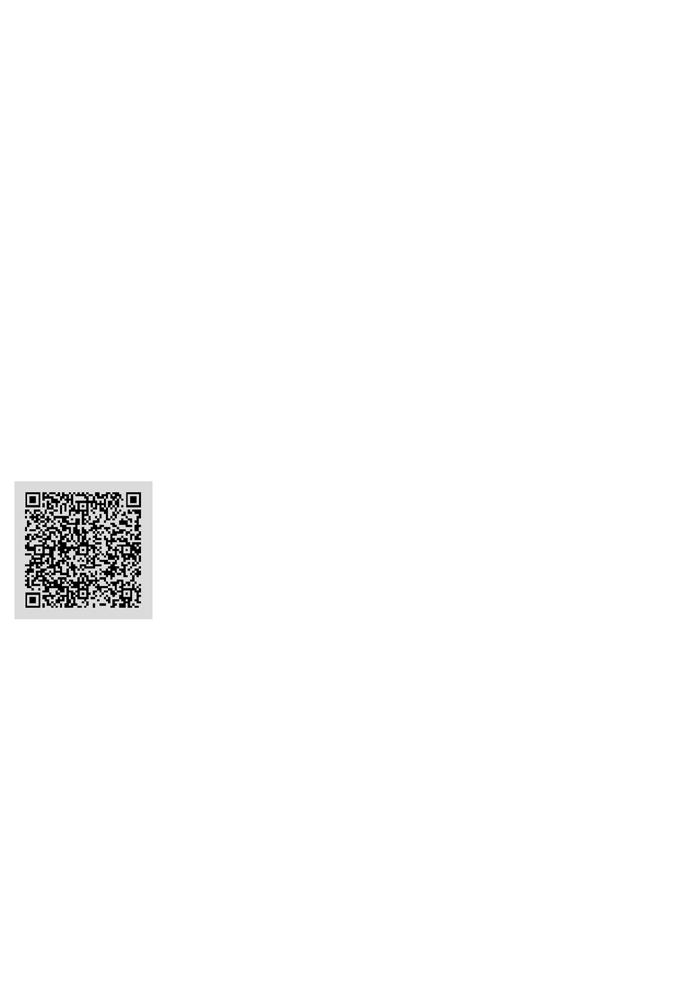

ERETZ HEMDAH ASK THE RABBI SERVICE
FROM THE VIRTUAL DESK OF THE OU VEBBE REBBE
RAV DANIEL MANN
Reattaching Ripped Tzitzit
Question: One of my tzitzit strings ripped so that it was very short. May I tie the ripped part to the stub to restore it to legal length?
Answer: According to your description, the tzitzit are kosher without reattachment, as we will explain. If the other tzitzit are of kosher length (details are not our focus) and only one string ripped, the tzitzit remain kosher for the following reason. The Shulchan Aruch (Orach Chayim 12:1) cites two opinions on leeway regarding ripped tzitzit strings. The Ri posits that each of the four strings can be “too short” on one of its ends if the other end is the proper length. (Background – each corner of the tzitzit has four strings, which look like eight because both ends of the strings face in one direction. One can know the pairings of the string ends if he, as
 RAV DANIEL MANN
RAV DANIEL MANN

recommended, was consistent about keeping the same four string ends together on opposite sides of the knots.) Rabbeinu Tam holds that two of the four strings must be complete on both ends. If only one of the eight strings became too short, the tzitzit are kosher according to all.
Now to your question about whether it is possible to fix tzitzit by tying on a string to a stub. Retzuot of tefillin that are tied together are not kosher (Menahot 35b; Shulchan Aruch, OC 33:5) because we derive from the word “u’kshartam” that there must be a kshira tama (i.e., attaching the tefillin with unblemished retzuot). The Taz (OC 12:3) and Magen Avraham (15:1) posit that the disqualification of tying is unique to tefillin, as generally, things that are connected by a permanent knot form one halachic unit. The Magen Avraham points out, for example, that when threads are tied together, their new size counts regarding size requirements of the laws of nega’im. Although there are some halachic comparisons made between tefillin and tzitzit, here it makes sense to follow the precedent found in the gemara (Menachot 35b) that the remnants (gardumei) of tzitzit strings are kosher, whereas the remnants of tefillin retzuot are not because tefillin have a level of sanctity that tzitzit do not.
The Taz, though, points out that the connection needs to be made at the right time, because of the concept of ta’aseh v’lo min
66 TORAH TIDBITS 1556 / VAYAKHEL תמשנ יוליעל ל"ז ןמצלז לאיזוע םהרבא ןב םירפא לאוי
Gemach for Chatan and Kalla: Meals for wedding and Sheva Brachot at cost Eida Hachareidis Hechsher Tel:052-633-1744 gadgadood@gmail.com
Eretz Hemdah, the Institute for Advanced Jewish Studies, Jerusalem, is headed by Rav Yosef Carmel and Rav Moshe Ehrenreich, founded by Rav Shaul Yisraeli, zt”l, to prepare rabbanim and dayanim to serve the National Religious community in the Israel and abroad. Ask the Rabbi is a joint venture of the OU, Eretz Hemdah, and OU Israel’s Torah Tidbits. he’asuy (=tvlmh). This means that regarding mitzvot that require acting to create the object of the mitzvah (including sukka or tzitzit), the creating must be significant at the time it was done, as opposed to receiving its significance retroactively. For example, if one tied three sets of tzitzit strings on a three cornered garment (for which there is no mitzvah of tzitzit) and later forms a fourth corner, the existing sets of strings are invalid until he redoes them (Shulchan Aruch. OC 10:5). So, says the Taz, if one tied strings together before attaching the tzitzit to the garment, all is fine. However, if one originally attached tzitzit strings that were too short and tied on extensions afterwards, it is pasul because of tvlmh.
What is more complicated is when the tzitzit were fine when they were attached, later strings ripped, and one wants to return them by tying. This seems to depend on a difference of opinion regarding a case of a mitzvah that was done properly, lost relevance, and was restored (see Pitchei Teshuva, Yoreh Deah 286:13, regarding mezuzot on a doorway which went in, out, and back into obligation in mezuza). The Ba’er Heitev (OC 12:3) cites our Taz as saying that our case would be fine, but the Sha’arei Teshuva (ad loc.), Eliya Rabba (12:1), and Mishna Berura (12:7) point out that the correct reading of the Taz is that it is pasul.
However, the Mishna Berura (ibid.) points out that if one fixed a string when the tzitzit

Having a dispute?

had enough kosher strings, it is not a problem of tvlmh, and the string apparently counts in your case. The value of fixing can show itself if other strings rip even later. Also, an individual short string is not optimal (see Taz ibid.), and reattaching the string apparently fixes that drawback.

077-2050015
052-2678749
golanechasim@gmail.com
Meir Golan
Old Katamon: 4-room apartment in a small and quiet street, 101 sqm, renovated, very bright and airy, master bedroom, Safe room (mamad), sukkah balcony, view, elevator, 3,400,000 NIS

RASCO: new 4 room apartment, 95m, master suite, elevator, balcony, very nice view 2,950,000 NIS
ARNONA: 3-room apartment, 73m, bright, Sukkah terrace, Shabbat elevator, fully accessible, green & quiet street, 2,450,000 NIS
Old Katamon: 4-room apartment, 90 sqm, well split, bright, airy, sukkah balcony facing a magnificent panoramic view, 3 exp Shabbat elevator, parking, 3,290,000 NIS
Old Katamon: Spacious 3-room apartment in a very quiet street, 75 sqm, sukkah balcony facing a green and pastoral view, 3 exp. Shabbat elevator, private parking, storeroom, 2,690,000 NIS
ARNONA: 4-room apartment, 90m, beautifully renovated, master suite, balcony, storage, Shabbat elevator, private parking 3,250,000 NIS
BAKA: 4 room apartment, 84m, elevator, neat & nice apartment, 2,850,000 NIS
BAKA: New 4 room apartment in a new building, 88m, master suite, storage, Shabbat elevator, private parking, 3,950,000 NIS
ARNONA: 4-room apartment, 90m, master suite, balcony, storage, Shabbat elevator, private parking, 3,290,000 NIS
RECHAVIA: 4-room apartment, 92m, Suka balcony, Shabbat elevator, fully accessible, private parking, storage 4,400,000 NIS
BAKA: New 4 room apartment in a new building, 88m, master suite, storage, Shabbat elevator, private parking, Sukkah balcony in process of being added 3,890,000 NIS
ARNONA: 5-room apartment, 120m, balcony, elevator, fully accessible, private parking, storage 4,350,000 NIS
ARNONA: 5-room apartment, 108m, balcony, nice view, Shabbat elevator, fully accessible, private parking, storage 4,290,000 NIS
BAKA: 5-room garden apartment, 140m, master suite private parking, storage, full of light, nice garden, 6,000,000 NIS
OLD KATAMON: 5-room garden apartment, 125m, Large garden + separate unit for rent or for guests, balcony, storage, 5,200,000 NIS
OLD KATAMON: Spacious new 5-room apartment, 140m, terrace, underfloor heating, Shabbat elevator, 2 parking, 6,300,000 NIS
FOR RENT:BAKA: nice 4-room apartment, 82m, beautifully renovated, master suite, air conditioners, balcony, second floor, elevator - fully accessible, storage, 8,000 NIS
NORTH TALPIOT (CASPI STREET): New garden apartment, 5.5 rooms, 165m, 80m garden, architecturally renovated, underfloor heating, central air conditioning, parking, 5,890,000 NIS
OU ISRAEL CENTER 67
For a Din Torah in English or Hebrew contact: Eretz Hemdah - Gazit Rabbinical Court
• Fax: (02) 537-9626
077-215-8-215
beitdin@eretzhemdah.org
Meir Golan

Transporting the Ark
The word halacha comes from the root, halach, to walk, to go, and the literal meaning of the word is the way to go. It can also be explained as how our tradition and practice develops and “goes” with the time.
On the one hand Jewish law is timeless and eternal, we hold the same traditions and practice the same laws as were given on Sinai. Shabbat will always be a day of rest, and we refrain from work on Shabbat, in the same way that all of the generations did since the Torah was given.
But, of course, the world changes and progresses, new technologies are developed and refined. As this happens, the halachic system is not stagnant or indifferent to such changes and developments. On the contrary, Poskim always examined new realities and attempted to view halachic questions and suggest the best and most relevant solutions in order to utilize the benefits of the technological advances, within the halachic framework.
There is a subtle allusion to this in the Mishkan and the vessels therein, appearing in the Parshiot that conclude the book of Shemot. The Aron, the Ark, contained the tablets and the broken shards of the first tablets. The Aron housed the Torah
and was the central element of the entire Mishkan. This is clear, since the Torah was, and remains, the focus of all worship and service of the Lord.
Similar to the Mishkan and all of the other vessels, the Aron could be moved, and, when the cloud indicated that it was time to move, Cohanim dismantled the Mishkan and carried the Aron with poles to the next location.
It is interesting and significant to note that even when the Aron was stationary, the poles that were used to carry it were still attached. The Cohanim never removed the poles and the Aron was always ready to be transported.
The message here is that the Torah is not static and stagnant. Rather, the essence, heart and soul of the Torah never changes, but the expressions of how to observe the Torah’s principles and guidance must be relevant to the current reality. The Aron is always ready to be moved from place to place, from the current situation to a new reality.
An excellent example of this is to be found in reproductive technology; the inception of reproductive technologies presented many opportunities and myriad challenges and the halachic world was able to find the most appropriate solutions.
More on this next time.
68 TORAH TIDBITS 1556 / VAYAKHEL
Machon Puah for Fertility and Gynecology in Accordance with Halacha
RABBI GIDEON WEITZMAN
Refuah Shleima to Ruth Friedson

KNOW WHAT TO ANSWER
FREE COUNTER-MISSIONARY
Videos • Parsha Insights • Booklets • Counseling
Rabbi Bentzion Kravitz • rabbikravitz@JewsforJudaism.org
NACHI REALTY 054-461-3943
New Price - Rechavia
Ground floor completely accessible, spacious & airy, 4 rooms, 10m mirpeset, parking, tons of potential, 2 entrances so the 3rd bedroom can be used as a clinic /office or studio unit. 3.97m shekel
For Rent in Rechavia
Rashba street, 2 rooms, 50m, 1.5 bathrooms, mirpeset, small building, 12 stairs up. available from April. 5670 NIS/month
For Rent in Katamon
30m studio on Bustani street, ground floor, small garden, for independent people over 55. 3500nis/month incl va'ad bayit & heat.


OU ISRAEL CENTER 69
Be’er Tziporah a"h - Bottled Water Gemach
Walking down King George St. in Jerusalem and want a cold bottle of water?
Come help yourself to a bottle at 52 King George.
In loving memory of Yoni’s wife Tziporah a"h, a true Eishes Chayil, always full of chessed, kindness and laughter, and brought life and strength to so many people, that she touched! She was like Aron, who loved peace and pursued peace.

Yoni thanks Hashem for having the opportunity of having Tziporah in his life, to learn of her caring, patience and happiness, to overcome her challenges. May Tziporah's Neshama be a light onto the world, in a time of darkness, and may her Neshama shine to Gan Eden. Yoni misses Tziporah with tears in his eyes, as Hashem gave him a gift, a crown jewel, now he returns her to Hashem. With thanks and Toda. Love, Yoni
To help refill the supplysend tax deductible donations for Be’er Tziporah a"h Bottled Water Gemach to Chabad of RechaviaRabbi Yisroel Goldberg email Rabbi@JerusalemChabad.org
02 800-1717
www.JerusalermChabad.org/DonateShekels
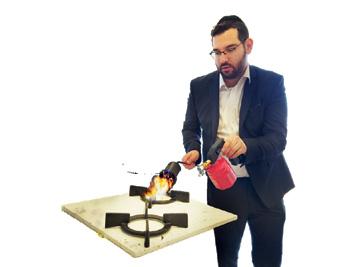

70 MAXI BoX 053-7272-815 ד״סב Storage Your place for extra space Flying Soon? Travel with Confidence 1UniTravel - Medical Insurance at great prices Choose from multiple options 1unitravel.brokersnexus.com 1UniSim - Sims for USA and Worldwide Starting at $40 sales@1unisim.com Call 077-400-3199 or USA 718-715-0001 Available online and at local Jewish bookstores For further information call: 0523-360553 NEW BOOK! הלענ הלע Eretz Yisrael and Aliyah in the Weekly Parshah
בוט יכ 'הל ודוה Pesach & year round kitchen kashering 026431427


































OU ISRAEL CENTER 71 IL: 972.52.682.9367 info@keteradvisors com US: 786.385.8859 www keteradvisors com Izzy Leizerowitz Broker Fee: 2% + VAT KETER ADVISORS: THE CROWN JEWEL OF ISRAEL REAL ESTATE Parcel 1 is already SOLD OUT! Parcel 2 Sale is underway! 25% PARCEL 2 SOLD IN JUST DAYS 18 Dunam Left – Zoned Agricultural 100K NIS per ½ Dunam(500 sqm) 190K NIS per Dunam (1,000 sqm) Pricing includes mapping, filing, initial taxes, legal fees Volume Pricing Discounts Available Have a USA IRA or 401k Plan? Did You Know You Could Buy This Land With Your Fund Money WITHOUT Penalty? Call Me And I Will Show You How Land Borders Israel National Trail Whole Wheat, Organic Whole Spelt, GF Gluten Free Oat Hand and Machine. Distributed throughout Israel Visit our website for details including Hechsherim, & ordering: www.MatzaMan.co.il matza2024@matzaman.co.il Women’s Workout Class Jrusalem Take control of your body Wednesday 10:30 am Hitzkiahu Hamelech Monday 7:30 pm Yonit -0547756576 Feel more secure walking, climbing steps, stay active Exercises are chair-based low impact and minimal stress on the joints Includes stretches that will improve mobility Individualized attention customized for specific issues
 SHOSHANA JUDELMAN
SHOSHANA JUDELMAN
The Arrivals Hall at Ben Gurion Airport
Since Simchas Torah, my vision has changed.
In writing this recurring column, I thought I would address various well known holy sites in Israel, bringing some thought or insight to enhance a visit. Instead, I find myself looking at our land and our lives through a completely different lens. And finding holiness in unusual places.
In the last two months I travelled out of Israel three times. And each time I was overcome with feelings of gratitude upon my return.
In Europe I am an oddity, my colorful head scarf loudly proclaiming my otherness, and my senses on constant alert as a result. I know that I do not belong, and the current political climate only intensifies these feelings.
So when I land back in Israel, I feel my shoulders relax, my breath come more easily and my heart fill with a sense of belonging.
There is no other place in the world where a Jew can feel so welcome and so immediately connected.
In 1798, Rebbe Nachman travelled by foot, carriage, and boat from Ukraine to Eretz Yisrael. It took him weeks.
It is told that when he finally arrived at
the Port of Haifa, he disembarked, walked four cubits, and stated that he was ready to return to Europe. Although he actually stayed 6 months, he explained that in those first few steps the spiritual tikun he had been seeking had already been affected.
Unlike Rebbe Nachman, the vast majority of us have, as our entry point, Ben Gurion Airport. And while we are by no means as sensitive to the effect Eretz Yisrael has on our souls, every one of us can feel the rush of energy and connection that occurs when we land. The somatic sense of being home.
As the gateway to reunion between Jews and our Homeland, the Arrivals Hall of

72 TORAH TIDBITS 1556 / VAYAKHEL
HOLY SITES IN ISRAEL
The hall, designed by Moshe Safdie, never fails to open my heart. The vast expanse, with its twin sloping paths, enables departing and arriving travelers to share space for a few moments, creating a bridge of achdus and shared intentions for successful journeys.
Currently, both sides of the hall are lined with hostage posters, breaking our hearts, and charging us with the mission of awareness. Some posters have handwritten notes, personal expressions of love and tefillah, which only add to the poignancy and immediacy of the call.
And at the end of the arrivals path, a giant mezuzah, broadcasting proudly that this is a Jewish place.
yet home.
May each of us be blessed to feel this protection in a real way.
And to come home.
Shoshana teaches Chassidus for the Shirat David Community in Efrat as well as in Jerusalem for Midreshet Rachel v’Chaya and Shiviti Women’s Institute. She is a guide in Poland with JRoots and co-leads inspirational trips to Ukraine and around Eretz Yisroel. Shoshana has also been a guide at Yad Vashem since 2014.
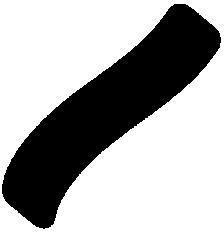
A mezuzah contains the words of the Shema- the credo of the Jewish People proclaiming our loyalty to Hashem and declaring His Oneness. The Torah tells us to affix these words to the doorposts of our homes and Chazal teach that the mezuzah guards the inhabitants of a house both when they are home and when they are away.
This mezuzah hangs on the symbolic “doorway” to Eretz Yisroel, embodying the concept of Hashem’s protection for Jews who are home and for those who are not



OU ISRAEL CENTER 73
Clara Hammer Chicken Fund continues to provide chickens for Shabbat and other basic necessities for over 200 poor and needy families every week.
can send your donations to: The Clara Hammer Chicken Fund P.O.B.
Jerusalem
| Tel. 02-582-3477
via PayPal at Chickenladyofjerusalem.com Or you can pay Hacker's Butcher Shop directly via credit card at Tel. 02-5819378
The daughter and granddaughters of Mrs. Chana (Hammer) Homnick a"h are carrying on the Chicken Fund in their grandmothers' memory.
The
You
18602
91185
Donate
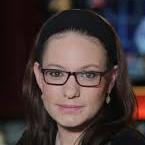

THE DAILY PORTION
BY SIVAN RAHAV-MEIR
BY SIVAN RAHAV-MEIR
How Do We Emerge From Darkness Into Light?
International Bible Quiz Champions Speak
International Bible Quiz Champions Speak
Much excitement has surrounded Emunah Cohen and Neta Lax, the two fresh winners of the annual International Bible Quiz. Yesterday I interviewed them and heard their story.
“How do we emerge from darkness into light?” This difficult question was asked by *Rabbi Chaim Sampson*, the host of a Project Inspire Shabbat event attended by more than a 1,000 people from all over the world. Among all the lectures and conversations on Shabbat, his answer to this question stood out.
Much excitement has surrounded Emunah Cohen and Neta Lax, the two fresh winners of the annual International Bible Quiz. Yesterday I interviewed them and heard their story.
It turns out that they studied long hours together and were confident they would be the leading competitors. "We planned on winning together," Emunah revealed. "We thought both of us would answer every question correctly so that we would both be champions, tied for first place.
the first time?' Yet I simply forgot it. I thought afterwards that HaShem caused me to forget the answer in order to remind me that I do not know everything, that I am human and not perfect."
the first time?' Yet I simply forgot it. I thought afterwards that HaShem caused me to forget the answer in order to remind me that I do not know everything, that I am human and not perfect."
"The more you learn," Neta said, "the easier it gets. When you learn a lot of Tanach (Bible) you simply see how everything connects to your life. I truly felt that what I learned accompanied me wherever I went. It made my heart feel good."
"The more you learn," Neta said, "the easier it gets. When you learn a lot of Tanach (Bible) you simply see how everything connects to your life. I truly felt that what I learned accompanied me wherever I went. It made my heart feel good."
Meir Lau. He rehabilitated himself and progressed in life. He married and raised a wonderful family. He was the Ashkenazic Chief Rabbi of Israel. He is the chairman of the Yad Vashem Council and one of the most famous spokesmen on Israel’s behalf and on behalf of the Jewish people throughout the world.
It turns out that they studied long hours together and were confident they would be the leading competitors. "We planned on winning together," Emunah revealed. "We thought both of us would answer every question correctly so that we would both be champions, tied for first place.
But in the end Emunah won. "They made a big deal about our big hug after I lost," Neta said. "But it was the easiest thing to share in her happiness. Besides, we were just relieved that the competition was finally over."
In the course of the entire contest, Emunah made only one error. "I knew the answer to the question: 'When did King David cry for
“So how do we emerge from darkness into light?” Rabbi Sampson asked. “Today there is so much sadness and grieving. I want to tell you about a 5-year-old child who lost his parents in the Holocaust. He was forced to leave his beloved home and, together with his big brother, endured a slave labor camp, a concentration camp, a death march, hunger, cold, and daily horrors. At the age of 8 when the war ended, he was illiterate. Instead of going to school he had to move dead bodies at Buchenwald, and simply did not know how to read or write. He made aliyah by boat and when he arrived in Israel was immediately sent to a detention camp in Atlit.
In closing, Neta declared: "The two of us will continue to study the Tanach. There were parts of the Tanach that were not in the material covered by the quiz, and it's important for us to learn them too."
In closing, Neta declared: "The two of us will continue to study the Tanach. There were parts of the Tanach that were not in the material covered by the quiz, and it's important for us to learn them too."
And Emunah had this recommendation:
"Study the Bible for 5 minutes every day. Not for school, not for the Bible quiz, but just for how much fun it will be."
But in the end Emunah won. "They made a big deal about our big hug after I lost," Neta said. "But it was the easiest thing to share in her happiness. Besides, we were just relieved that the competition was finally over."
In the course of the entire contest, Emunah made only one error. "I knew the answer to the question: 'When did King David cry for
NETANYA 4 ROOM APT. RENTAL,
NETANYA 4 ROOM APT. RENTAL,
Nitza Blvd, 1 month min. Amazing sea view, kosher, furnished: May, June, July 2023 from September 2023 short or long term
Nitza Blvd, 1 month min. Amazing sea view, kosher, furnished: May, June, July 2023 from September 2023 short or long term
APTNETANYA@GMAIL.COM
APTNETANYA@GMAIL.COM
What kind of future would you have envisioned for a child like this? Orphaned, abandoned, poor, without education, with unimaginable fears and traumas. I want to invite this child to the stage. He is already 87 years old. He is known as Rabbi Yisrael
And Emunah had this recommendation: "Study the Bible for 5 minutes every day. Not for school, not for the Bible quiz, but just for how much fun it will be."
Let us hope that children from Be’eri, Sderot, and Kfar Aza can gain strength from his story. This is not only a personal story of Yisrael, the orphaned child. This is the story of the nation of Israel. We have living proof in our generation of the ability to emerge from disaster to rebirth. It is a great privilege to hear the story of Rabbi Lau, our story, especially during this time.” May everyone hear good news.
Translation by Yehoshua Siskin
Sivan Rahav-Meir is a media personality and lecturer. Married to Yedidya, the mother of five. Lives in Jerusalem, and formerly served as the World Mizrachi Shlicha to North Amer
Sivan Rahav-Meir is a media personality and lecturer. Married to Yedidya, the mother of five. Lives in Jerusalem, and formerly served as the World Mizrachi Shlicha to North Amer



74 TORAH TIDBITS 1556 / VAYAKHEL OU ISRAEL CENTER 63
THE DAILY PORTION
OU ISRAEL CENTER 63
enumerated. Yishmael dies. His descendants dwell from Egypt to Assyria.
LIFE SETTLEMENTS
Yishmael’s story is brief. He has numerous and powerful offspring. The brevity
Do you have a life insurance policy you:
• No longer want?
• No longer need?
• Can no longer afford the premium?
A SHORT VORT
• Could you use extra money instead of keeping your policy?
Avihu, Elazar and Itamar. Nadav and Avihu died without children.
that King David expressed his wishes that his son Shlomo succeed him.
Adoniyahu convinces two very significant personalities - the High Priest and the commander of King David’s armies - to
BY RABBI CHANOCH YERES
R av, Beit Knesset Beit Yisrael, Yemin Moshe
I can guarantee that if you qualify with the underwriting process I can get you more money than if you cash it in with the company.
**SALE! Rechavia, Diskin St. 130 sqm. 3 beds + 2.5 baths + private parking. Facing city view. Needs renovation 5,700,000 ₪
When Avraham addresses the people of Cheit, trying to acquire a burial spot for his wife, he says
“Ger V’Toshav Anochi Eimachem” (23:4) “A Stranger and a Resident am I with you”
Please contact Moshe Russell at: Buymypolicy32@gmail.com
Elazar and Itamar serve as Kohanim with Aharon. Take the Leviim: they are to serve Aharon. The Leviim are responsible for the Mishkan: to support the Kohanim and the people, to facilitate the running of the Mishkan. The Leviim shall take the place of the first-born, who became obligated to me when saved in Egypt.
This seems to be a contradiction. If one is a stranger than he is not a resident, if he is a resident than he is no longer a stranger. What did Avraham mean?
The Magid of Dubno (Jacob ben Wolf Kranz 1741-1804) explains that Avraham watched how he spoke in this tense situation in order to, both, state his truth and be able to keep the peace -Shalom Bayit. Avraham said, on the one hand, “I am a Resident’ due to G-d’s promise to receive this Land and on the other hand, I still need your agreement to purchase a plot. In other words, Avraham implied “I am the resident” and you are the “strangers”, while they understood him as saying that “they” are the residents and Avraham is the stranger. The peace was kept, and Avraham remained true to his ideals.
Shabbat Shalom
A small Sefer Torah with its own Aron Kodesh is available to shiva houses or for any other necessary occasion on a temporary free-loan basis. If needed call Uri Hirsch 0545513173
**RENTAL! Nayot, Davidzon St. 100 sqm, 4-beds, 1st floor + elevator. Furnished or empty. Immediately. Short/long term. 7,900 ₪
**RENTAL! Talbiyeh, 130 sqm penthouse 3 5-beds, F/F, large terrace, private parking + storage. 13,500 ₪
Ruth Abrahami - 054-8070677


There are 2 groups mentioned here: Kohanim and Leviim. The lineage of the Kohanim is given. It just doesn’t take much room. Because Aharon is a Kohen and his sons. But he only has 2. So the entire lineage of the Kohanim is 3 people. The Leviim, on the other hand, are an entire tribe,
Every person who was not born in Israel and lives in the Holy Land should celebrate his/her ALIYANNIVERSARY annually! REMEMBER! WITH ALIYAH BLESSINGS!
We are a young senior couple looking for a 1 bedroom furnished apartment in Jerusalem from December 2021-June 2022
The NEAMANS
0524419731

ports Levi the ilies had 3 of the The on Gershon, responsibility fell furniture. care the And replace

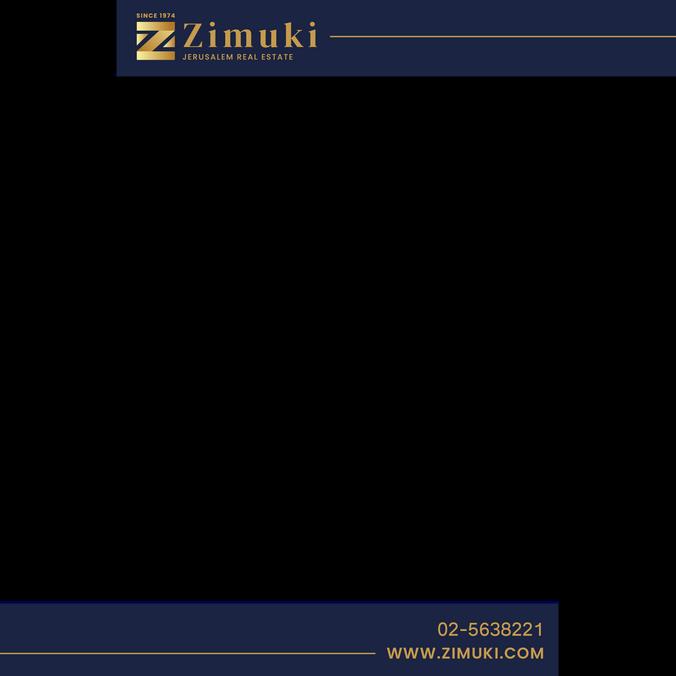
See What We Do and to Donate: www.Yeshezra.org
Bank transfer: Mercantile (17), Branch 642, A/C 79747843
Send Asmachta for tax receipt
Checks: “Yesh Ezra,” POB 31476, Romema, Jerusalem Credit Card: Sara – 077-820-0196.
Sun/Mon/Wed (10:15am-2.45 pm)
Inquiries: Menachem Persoff 050-570-1067 | menpmp@gmail.com
OU ISRAEL CENTER 75
14 TORAH TIDBITS 1516 / BAMIDBAR
12 TORAH TIDBITS 1440 / CHAYEI SARA 5782
boys from broken families urgently need help to prepare for, and celebrate, their Bar Mitzvot
Two
HELPING THE HOME FRONT ASSISTING THE NEEDY

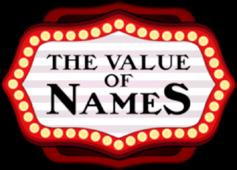
“Very




OU ISRAEL CENTER 77 Yehoshua Looks, Esther Eisenberg, Theatre Zion presents: Tickets: theatrezion.co.il 02-630-3600
little gem all around.” - Baltimore Sun
and wise...”
Chicago Magazine
“A
“Funny
-
moving, beautifully written.” Chicago Tribune Securities offered through Portfolio Resources Group. Inc., member of FINRA, SIPC, MSRB, SIFMA U S B R O K E R AG E S E R V I C E S I N I S R A E L Get the Best of Both Worlds Kee p yo ur mo ney in th e US an d rec ei ve lo ca l exp er t in vestm en t advice 02-624-0995 054-599-9530 aaron@lighthousecapital.co.il www.aaronkatsman.com CALL


YACHAD
Torah Tidbits is proud to now share a monthly dvar Torah from OU Israel's Yachad program. It is an honor to share insights from Yachad members and their madrichim who will present their unique perspectives on the parshat hashavua. Welcome to the pages of Torah Tidbits!
worthy, we attach ourselves to the “klal” in the performance of mitzvot. And when we are together as a “klal”– united as “Yisrael” –we are righteous and worthy.
Rav Berezovsky explains that this was the essence of the good news Moshe delivered after chet ha-egel. Hashem accepted Moshe’s request to view chet ha-egel not as a collective sin [mistake], but rather as numerous individual sins [mistakes.] It is because of the togetherness of the “klal” that “amech” can be deemed “tzadikim.”
After successfully pleading to Hashem on Bnei Yisrael’s behalf after chet ha-egel, Moshe gathered the nation. The primary purpose of this assembly was to inform Bnei Yisrael about the Mishkan – Hashem’s dwelling among the people – and the guidelines for its construction.
Various Hasidic teachings suggest that this order of events is no coincidence: the atonement and the mishkan are intertwined. In Netivot Shalom, Rav Sholom Noach Berezovsky quotes the Noam Elimelech on Devarim, in which Rebbe Elimelech of Lizhensk discusses the kabbalistic custom of stating “l’shem yechud b’shem kol Yisrael” before each mitzvah. This is a statement that one is about to serve Hashem and seeks to draw His presence into the performance of that mitzvah.
Noam Elimelech suggests that there is a world called “Yisrael” in which all sins and mistakes are absolved through the concept of “v’amech kulam tzadikim” (Isaiah 60:21). Although we may or may not be individually
This gives further insight into why Moshe immediately gathered the people. Moshe says, “eleh ha-devarim asher tzivah Hashem la-asot otam” (Exodus, 35:1). At first, the flow of the pesukim may seem odd, since the pesukim that follow discuss not violating Shabbat and mitzvot lo taaseh, actions we are forbidden to do. However, the Netivot Shalom says that, on the contrary, the gathering is about what we are commanded to do – gather together, unite, and identify as “klal Yisrael.”
The relevance of the concepts of unity and togetherness today are likely very obvious. In this challenging period for our people, it is unity that allows us to feel strength and an incredibly deep-rooted sense of community. This is our daily message here at YACHAD; it is one we are proud to proclaim loudly to the world. When we are together, we are invincible and have unlimited potential. With Hashem in our midst, this has long remained the secret to our perseverance and success.
78 TORAH TIDBITS 1556 / VAYAKHEL
חצננ דחיב !ונתודחאב ונחוכ
This dvar Torah is a summary from a chavrutah between Aviyah Atkin, Yachad Israel Director of Engagement and Yachad Jerusalem Chapter participant Yitz Shmidman.
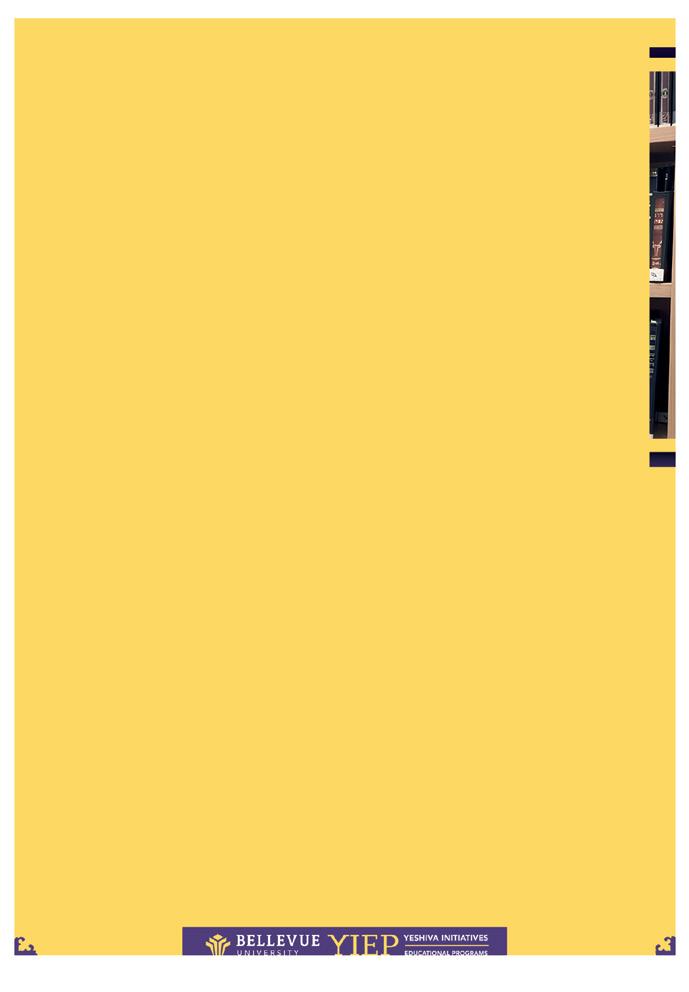


Maximize Your Tzedaka With Stocks Donations Turn your stocks into support for any Israeli charity, take advantage of significant tax benefits, and build your philanthropic path with JGive Platinum’s donor-advised fund (DAF).
more information, email us at platinum@jgive.com or scan the QR code:
above should not be misconstrued as tax advice, legal advice, a recommendation, or an opinion regarding the advisability of participating in financial products of any kind or type, including but not limited to participation in donor-advised funds (DAF). The above is not meant to be a substitute for personal advice tailored to the client's needs, nor does it take the place of advice given by qualified professionals. No Capital Gains Tax
For
The

























 donated by Marion & Michael Silman Ita Rochel 02-560-9125
donated by Marion & Michael Silman Ita Rochel 02-560-9125



















































































































































 RAV DANIEL MANN
RAV DANIEL MANN






































 SHOSHANA JUDELMAN
SHOSHANA JUDELMAN























